Survey of London: Volume 46, South and East Clerkenwell. Originally published by London County Council, London, 2008.
This free content was digitised by double rekeying. All rights reserved.
'St John's Gate and St John's Lane ', in Survey of London: Volume 46, South and East Clerkenwell, ed. Philip Temple (London, 2008), British History Online https://prod.british-history.ac.uk/survey-london/vol46/pp142-163 [accessed 15 April 2025].
'St John's Gate and St John's Lane ', in Survey of London: Volume 46, South and East Clerkenwell. Edited by Philip Temple (London, 2008), British History Online, accessed April 15, 2025, https://prod.british-history.ac.uk/survey-london/vol46/pp142-163.
"St John's Gate and St John's Lane ". Survey of London: Volume 46, South and East Clerkenwell. Ed. Philip Temple (London, 2008), British History Online. Web. 15 April 2025. https://prod.british-history.ac.uk/survey-london/vol46/pp142-163.
In this section
CHAPTER V. St John's Gate and St John's Lane
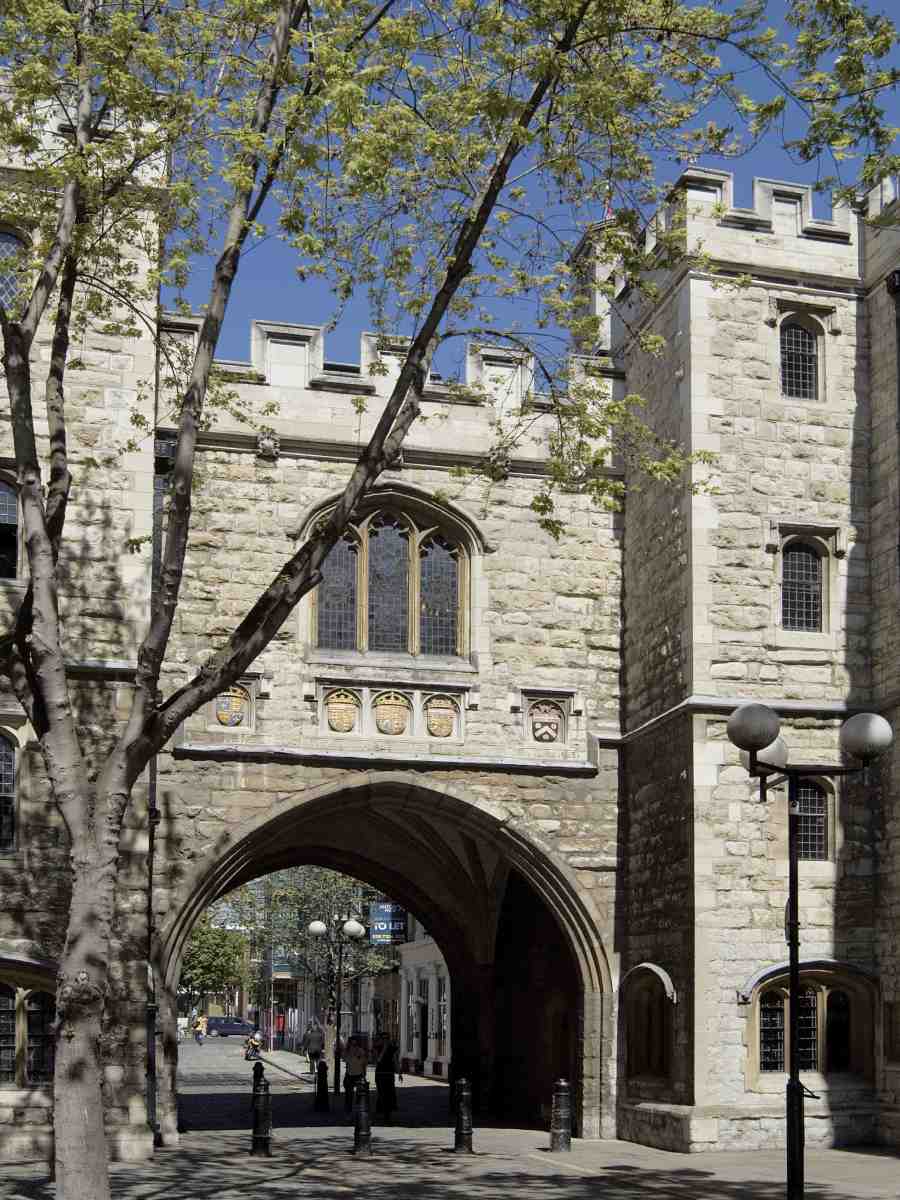
173. St John's Gate, south front in 2007
Prior Docwra's Great Gate, completed in 1504, was the main entrance to the walled inner precinct of the priory of St John, and is now, much restored, the only substantial remnant of monastic fabric to survive above ground (Ill. 173). Some time after the dissolution of the priory it became a dwelling-house, and later part coffee-house, part printing-house; here the Gentleman's Magazine was produced in the eighteenth century, and Dr Johnson worked in a garret. Since the 1870s it has been the headquarters of the revived English Order of St John, and today, with adjacent buildings, contains the Order's museum, library and offices. The gateway has been closed to traffic since 1985 to avoid vibration from heavy vehicles. (fn. 1)
The approach road to the priory, St John's Lane (Ill. 174), was laid out in the twelfth century, but apart from its relationship with the Gate has nothing to suggest antiquity or confer much obvious character. The entire west side, bomb-damaged in the Second World War, is lined with unexceptional commercial blocks dating from no further back than the 1960s. The east side retains some older fabric—Victorian warehousing to the north, two or three late Georgian houses towards the south end.
Connecting the lane with St John Street is a narrow passage called Passing Alley. This no longer follows its historic path, which dated back to monastic times and was a continuation of what is now Briset Street, leading east from Butt Close. It was moved some way south as part of a late Victorian redevelopment. Passing Alley is not its old name either, for Ogilby & Morgan's map (1676) and Rocque's map (1747) call it Pissing Alley. The present name is no Victorian euphemism, however, appearing on Horwood's map first published in the 1790s.
Historical introduction
St John's Lane may have been laid out so that the route and the gateway at its top end aligned with old St Paul's Cathedral. (fn. 2) Its position may also have been determined by any early ribbon development along the west side of St John Street. A second gate at the south had been built by about 1400, confirming its status as an essentially private road.
During the monastic period the lane became lined with houses occupied by Hospitaller knights and their servants, the east side being the more densely built up. Many plots here, as today, had frontages to both St John Street and St John's Lane. The better properties were at the north end, close to the Gate, where the plots were longer, and in the early 1500s Prior Thomas Docwra and his brother held a large house here, of quite recent date, with a great hall, chapel, gardens and orchard. (fn. 3)
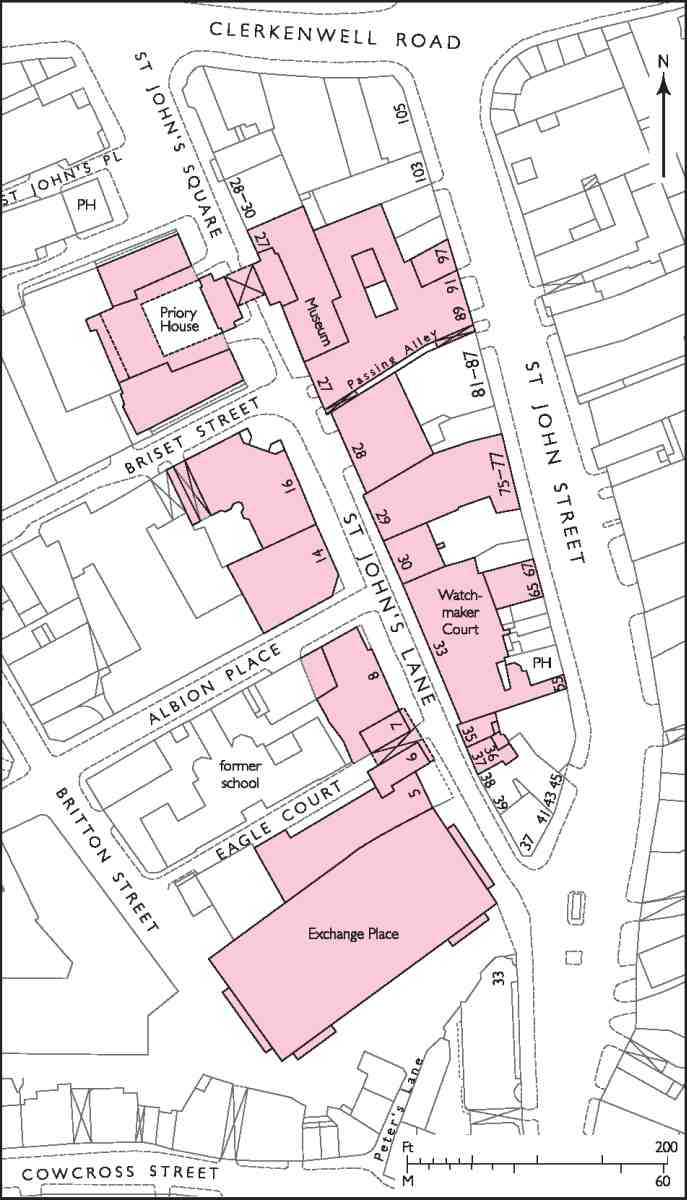
174. St John's Lane area
On the west side, which gave scope for much bigger plots and gardens, at least two mansions had been erected before the Dissolution. One was the Bailiff of Eagle's House at the south end, a stone edifice built, probably in the mid-fourteenth century, as the official residence of a senior officer, the Bailiff of the former Templar preceptory of Eagle in Lincolnshire (see Ill. 129, page 116). Further north, on a site later occupied by the gardens of Berkeley House, was a house of c. 1520, a date suggested by the archaeological evidence of mouldings, panels and plaques of terracotta, a Renaissance taste in architectural decoration then enjoying a vogue at the very highest levels of society. During the 1530s this house was the residence of the prominent courtier Thomas Tonge, Norroy and later Clarenceux King-of-Arms. The building had been demolished by the 1580s. (fn. 4)
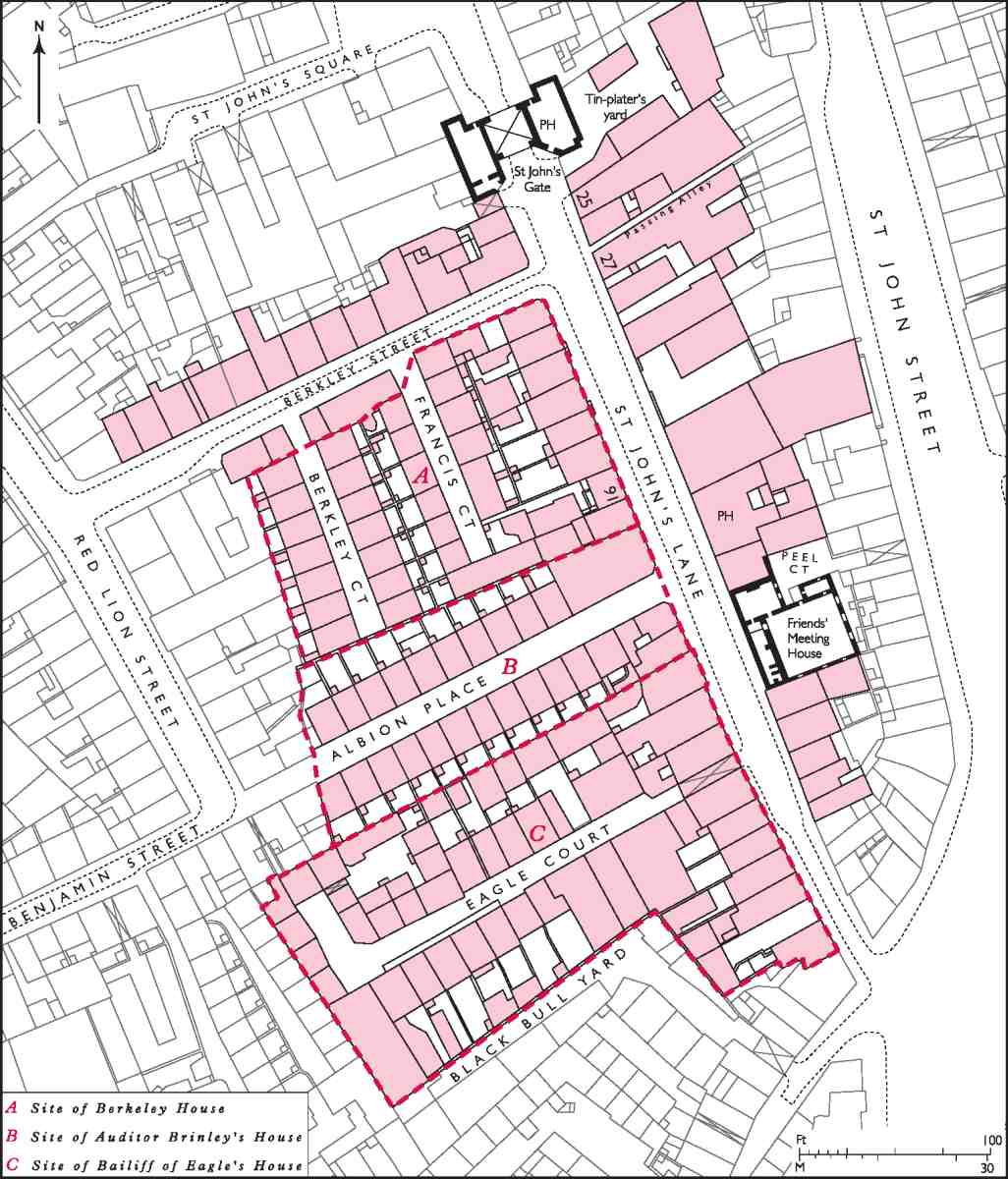
175. St John's Lane area in the mid-1870s; sites of post-Dissolution mansions and gardens are outlined in red
Like the inner precinct beyond the gate, St John's Lane made an easy transition after the Dissolution into a residential address for members of the secular elite, with a mixture of old and new houses. By the 1580s the Docwras' house near the Gate had passed to the Cranfield family, and forty or fifty years later was one of several houses in London owned and occupied by Lionel Cranfield, 1st Earl of Middlesex. (fn. 5) It was subsequently the residence of Sir John Keeling (later Chief Justice of the King's Bench), who imprisoned Bunyan and was the model for Lord Hategood in Pilgrim's Progress. (fn. 6)
A little further south, on the site of the present No. 30, was the house of Sir Thomas Forster, Judge of the Court of Common Pleas, who died there in 1612. A jettied building, with large bay windows, painted glass and carved grotesquerie, it survived in part to become a public house, the Old Baptist's Head, but had been much altered before its final rebuilding in the 1890s (see Ill. 176 and page 161). Three old houses to its rear facing St John Street, demolished in the early nineteenth century, were part of the same property, if not the house itself (see Ill. 258 on page 204). (fn. 7)
The largest buildings in this post-Dissolution period were the Bailiff of Eagle's house and two mansions to the north. Long gone, their sites were still discernible in property boundaries in the late nineteenth century (Ill. 175). One, on the site of present-day Albion Place, was the residence in the 1620s and 30s of Thomas Brinley, Auditor to the Exchequer. (fn. 8) After the Restoration, the house was owned and occupied until c. 1685 by George Walsh, a Worcestershire landowner and Gentleman of the Privy Chamber. (fn. 9) North of this was Berkeley House, a brick-built mansion of H- or U-plan, thought to have been built not long before his death in 1581 by the royal standard-bearer Sir Maurice Berkeley (see Ills 178, and 135 on page 119). A descendant, the 9th Baron Berkeley, later the Earl of Berkeley, lived there until the 1680s, when the house became briefly a centre of Roman Catholicism, under the Benedictine Father Maurus Corker. (fn. 10) A chapel or 'convent', known as the 'Factory', it was attacked during the anti-Catholic riots that greeted news of William of Orange's arrival in England in 1688, and left in ruins. (fn. 11)
The Bailiff of Eagle's house was demolished in the 1640s, and it was probably then or soon after that a street called Vinegar Yard was laid through the middle of the plot, its name suggestive of industrial activity inimical to the Lane's residential character. (fn. 12) General redevelopment became inevitable with the migration of wealthy residents to the West End towards the end of the century, and the remaining mansions on the west side were gradually replaced by side streets with small houses. As in the former inner precinct north of St John's Gate, most of the rebuilding was accomplished between the 1680s and the 1720s. Vinegar Yard itself was redeveloped with houses in the 1680s, later becoming known as Eagle Court. (fn. 13) At about the same time the site of Auditor Brinley's house was covered with small houses, mostly in a new side street, George Court; the principal builder here was Richard Frith, best known for his work in Soho. (fn. 14) A good deal later, between about 1706 and the early 1720s, rows of small houses in Berkley (now Briset) Street, Berkley Court and Francis Court were built on the Berkeley House site. (fn. 15)
This period of redevelopment saw St John's Lane become a centre of printing, for which the location was ideal, being close to the City but outside the control of its guilds and companies. (fn. 16) By the 1720s there were at least seven establishments here, including those of the Holt family at St John's Gate (page 149) and James Bettenham, who helped set up William Caslon as a type-founder. (fn. 17) Isaac Basire, the printmaker and draughtsman, lived and worked in a house on the west side, at No. 16, from c. 1739, his sons John and Isaac carrying on the business there after his death in 1768. (fn. 18) Other trades and industries to settle in the lane were brewing, jewellery, clock- and watchmaking, furniture-making and associated businesses. (fn. 19)
On the west side, the early eighteenth-century street pattern—houses, shops and inns along the lane, with lesser houses in the side streets and courts—stayed largely unchanged until the Second World War. George Court was entirely rebuilt in the 1820s as Albion Place, but this was simply a case of like for like. Two characteristic pieces of Victorian redevelopment were the shoehorning of a board school into Eagle Court (page 178), and the building of private model dwellings (Dundee Buildings, described as 'rough' in the 1890s) on the south corner with Berkley Street. (fn. 20) Contrasting with the small shopkeepers in the lane were the denizens of the increasingly run-down and crowded backland: by the 1890s typically costermongers and unskilled labourers. In the summer of 1898 Charles Booth's investigators found it rather squalid, noting a 'fearful stench' from a Gorgonzola factory as they walked up the lane, and a man in Francis Court toting a bloody bag of sheep's necks, which he was off to hawk at twopence a pound. (fn. 21)
Along the east side in the eighteenth and nineteenth centuries there were industrial premises and open yards, with taverns, a Quaker meeting-house in Peel Court, and a mixture of old timber dwellings and newer brick-built houses and shops (Ills 175, 176). Next to St John's Gate throughout much of the nineteenth century was a tinplater's works. (fn. 22) A little further south, beside Passing Alley, stood an old weather-boarded house at No. 27 which from c. 1818 till the 1880s was occupied by a japanning and ironmongery business. In the last two decades of the century, after the construction of Clerkenwell Road, the old premises at the upper end gave way to comparatively tall warehouses.
During the Second World War Nos 31–34 on the east side of the lane, including Peel Court meeting-house, were destroyed. Most of the buildings on the west side from No. 1 to No. 13, and No. 18, were all damaged beyond repair. (fn. 23) Soon after the war a number of temporary buildings were put up, including a cold-meat store at Nos 31–34 in the late 1940s. About the same time an electricity substation, of concrete construction, was built on the site of Dundee Buildings. (fn. 24)
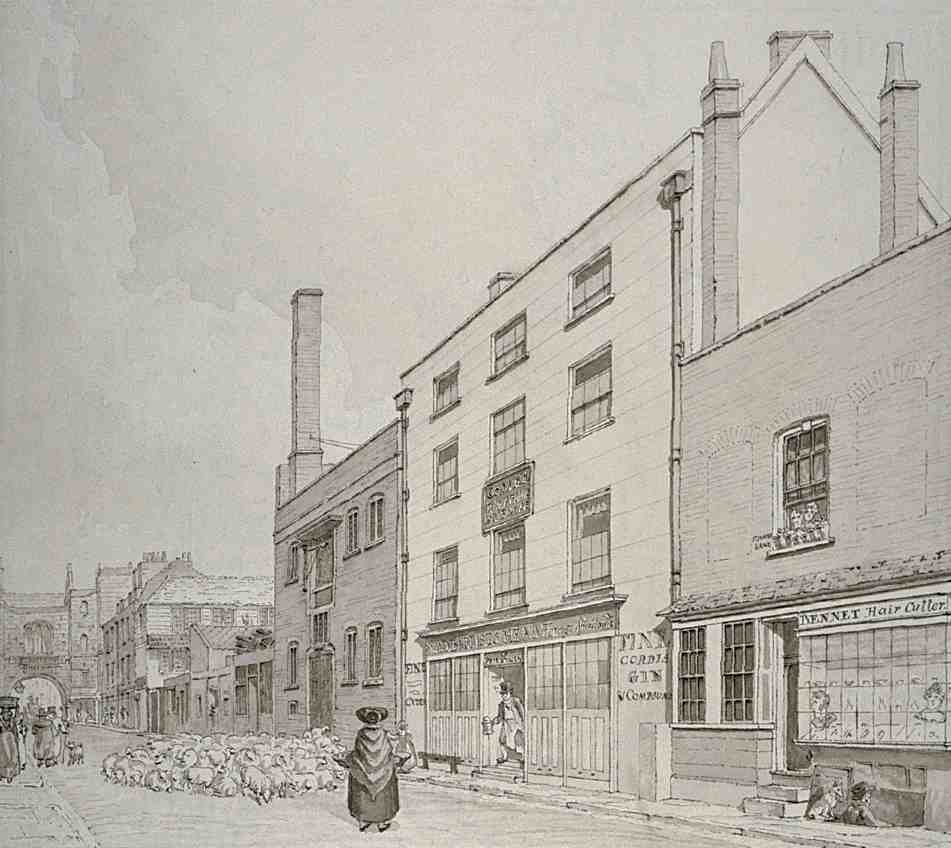
176. View north up St John's Lane, 1820s, showing the re-fronted Old Baptist's Head
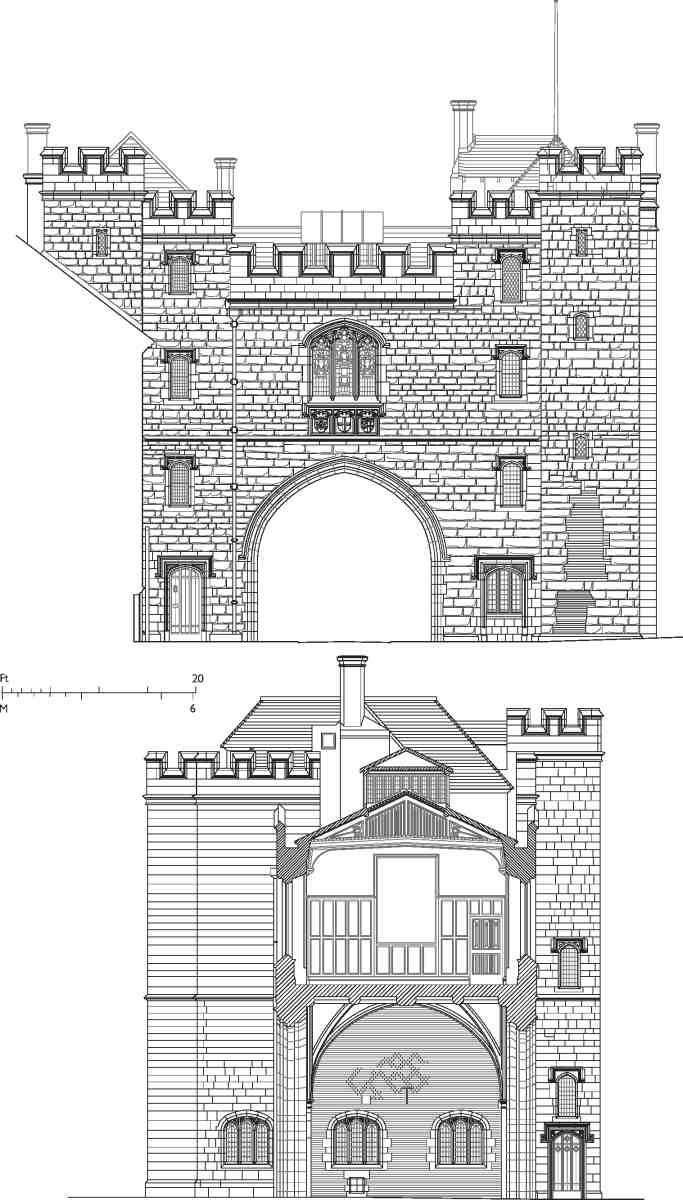
177. St John's Gate, north elevation and section looking west
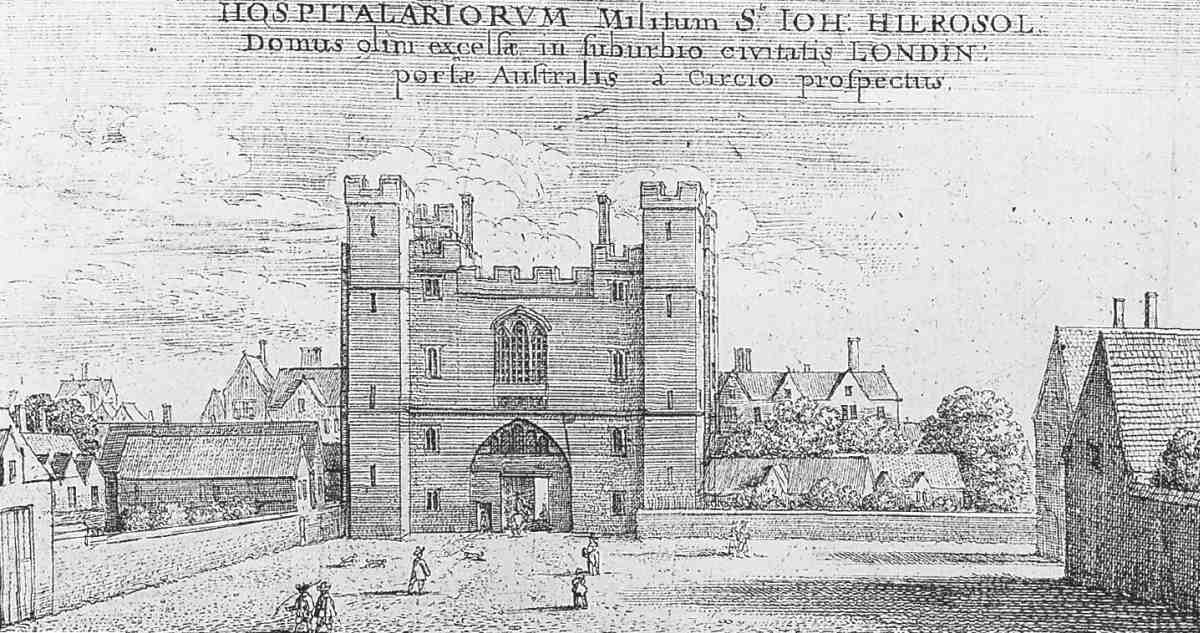
178. St John's Gate, north front, c. 1661. Behind the gate to the right is Berkeley House
Until the 1970s this was still an industrial district, with the meat and cold-storage trade to the fore, and most of the few new buildings and conversions of the time were for warehousing. (fn. 25) Since the 1980s there has been a number of new office developments, and the older surviving buildings have been turned into offices, studios and apartments.
St John's Gate
St John's Gate as we see it today is to a large extent a Victorian reinvention of the Tudor original, the result of successive phases of restoration and alteration by the architects W. P. Griffith, Richard Norman Shaw and, lastly and most comprehensively, John Oldrid Scott— work which reflects the development of attitudes to the reinstatement of historic buildings during the nineteenth century (Ills 173, 177).
It was not the first gate, but replaced a much earlier structure probably contemporary with St John's Lane and the inner precinct wall, both of which are known to have been in existence by the 1160s. The earlier gate, on the evidence of twelfth-century masonry discovered near by, was ashlar-faced with carved ornamentation; fire damage to the stone may be from the sack of the priory by the Poll Tax rebels in 1381. Some of the old ragstone was possibly reused in the basement walls of the present building. (fn. 26)
The Great Gate of 1504
Thomas Docwra became Grand Prior of the English langue of the Order of St John in 1501, and it must have been soon afterwards that work on rebuilding the gate began. The south front originally carried an inscription commemorating Docwra's authorship, and was embellished with five carved shields; these were replaced during J. Oldrid Scott's restoration in 1896. On the north side are three shields, heavily restored, but the inscription 'ano dni 1504' which once ran beneath is no longer visible.
Sixteenth-century documents refer to the building as the great stone gate (magnam portam lapideam). The superstructure is in fact constructed almost entirely of red brick, the walls being three feet thick, and mostly faced with stone. (fn. 27) Before his restoration, Scott identified the sixteenth-century work as mostly of Reigate firestone, with dressings of Kentish rag. (fn. 28) The vaulting is also of stone, four-centred and quadripartite, with bosses representing the Agnus Dei and the arms of Docwra and the Order. On the inner walls the brickwork was left exposed and decorated with diaper-work, some of which has survived on the western wall beneath the arch (Ill. 177).
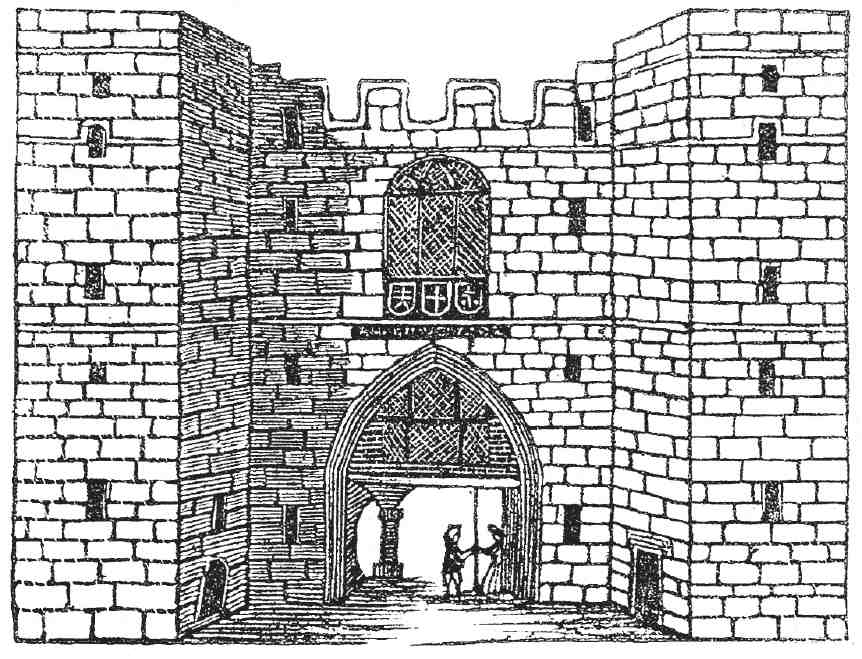
179. St John's Gate, north front, mid-eighteenth century. One of a number of woodcuts made for the Gentleman's Magazine, but apparently never used
Only one depiction of the gate earlier than the eighteenth century has survived: Hollar's view of the north front, of c. 1661 (Ill. 178). This shows it to have had, like the priory church, a battlemented parapet, and it also shows the original proportions of the archway, now obscured by the raised level of the roadway. As the blocked, sunken north doorway to the east stair-turret shows, this was originally some three feet lower. A corresponding doorway on the west stair-turret was raised to its present position in 1866; its carvings of a cock, hawk, hen and lion, recorded in the late eighteenth century, have now so deteriorated as to be barely recognizable.
Hollar's view shows an extra room, probably of wood, inserted under the vault, with partitions separating an entrance for pedestrians from another for horses and vehicles. Eighteenth-century engravings show a more permanent-looking arrangement, with two stone arches to the south front, and a brick-and-timber room above (Ill. 179). These additions were removed in the 1770s. The pivot of one of the hinges which carried the wooden gates on the south side of the arch still survives, in the west jamb.
The towers flanking the archway, rectangular in plan, are of four storeys with a cellar, and each has a stairturret attached on the north side and a garderobe tower to the south. With the exception of partitioning at the northern end of some rooms in the towers, the internal layout today probably differs little from the original (Ill. 180). Over the arch is a large square room communicating with both towers at second-floor level, probably intended as a hall or meeting-room; it was refitted in 1885–6 and is now the Council Chamber. Both towers originally contained spiral staircases—stone to first-floor level and wooden above—and the west tower retains its upper stair, with a chestnut newel and oak treads (Ill. 181); the section beneath is a mid-nineteenth-century replica. The east tower stair dates from the mid-seventeenth century. Throughout the west tower the doorways leading off the staircase are of the original moulded Reigate stone; another original doorway connects the east tower to the Council Chamber. The ground-floor room of the west tower has two blocked windows in its west wall, which would have overlooked the Sub-Prior's garden, to the south of the precinct wall. Also in this wall, above an early twentieth-century fireplace by Scott, there is a three-centred brick arch belonging to the original, much larger chimney opening.
With the exception of the Council Chamber, the ceilings throughout the building are panelled in a sixteenth-century manner. They certainly predate the restorations of the nineteenth century and some may be original. The oak ceiling beams on the ground floor are moulded, those on the first and second floors simply chamfered. Early descriptions and a view of a proposed 1850s 'reinstatement' suggest that the ceiling of the Council Chamber was formerly of this second type, but with decorative shields and armorial bearings at the intersections, probably added at a later date. (fn. 29) In the uppermost rooms the timbers of the low-pitched roofs are exposed, and ceiled with wooden panels between the closely spaced rafters.
Post-Dissolution history, c. 1540–c.1672
It is not known how the Great Gate was used during the confused period of dissolution, restitution and final suppression of the English Hospitallers in 1540–59. Later in the century, during the priory's occupation by the Offices of Tents and Revels, a porter was stationed at the gate, but most of the rooms were held by one of the Crown's officers as his residence. In the 1580s, Henry Middlemore, gentleman of the Privy Chamber and ambassador, had seven chambers and a cellar in the gatehouse, and rooms in an adjacent building. (fn. 30)
In 1604 James I granted the gate to Sir Roger Wilbraham, Master of Requests and Surveyor of Liveries in the Court of Wards, perhaps in recognition for long service as Elizabeth's Solicitor-General in Ireland. (fn. 31) Wilbraham used it with nearby buildings as his residence, and after his death in 1616 the property descended via his daughter to her husband's family, the Pelhams, later Dukes of Newcastle. (fn. 32)
From the mid-1660s until the early 1670s the gate was occupied by (Sir) Richard Levett, later a director of the Bank of England and Lord Mayor of London. He was probably responsible for several alterations. (fn. 33) One is the wooden dog-leg staircase inserted into the east tower, the walls of the stairwell being cut back to accommodate its straight flights. This has heavy, square newel-posts topped by ball-finials (since replaced), and thick, turned balusters (Ill. 182). Another appears to have been the replacement of the room shown in Hollar's view in the archway beneath the central hall. The publisher Edward Cave, writing in the 1740s, said this room had been built 'or rather thrust under' the vault by Levett immediately after the Great Fire of London. (fn. 34) As the arched entrances on the south side shown on eighteenth-century views seem to have been related to it structurally, they may also have been Levett's work (Ill. 179).
Printing-house, coffee-house and tavern
St John's Gate has long been celebrated both as the birthplace in 1731 of Edward Cave's Gentleman's Magazine, and as the workplace of Samuel Johnson. Less well known are the building's earlier connections with the literary world, during the 1670s, and the existence of a press there from the early 1680s.
The literary connection began with Matthew Poole, the Presbyterian divine, who succeeded Richard Levett as principal ratepayer at the gatehouse in the 1670s. A large part of Poole's multi-volume biblical commentary, the Synopsis, was written during his residence here, where at first, in the late 1660s, he appears to have been sharing the premises with Levett. The work was printed in Little Britain, but the business of publishing and selling it was carried on at the Gate. (fn. 35) Marked down for assassination by Titus Oates in the Popish Plot of 1678, Poole left Clerkenwell shortly afterwards for Holland, where he died in 1679. (fn. 36)
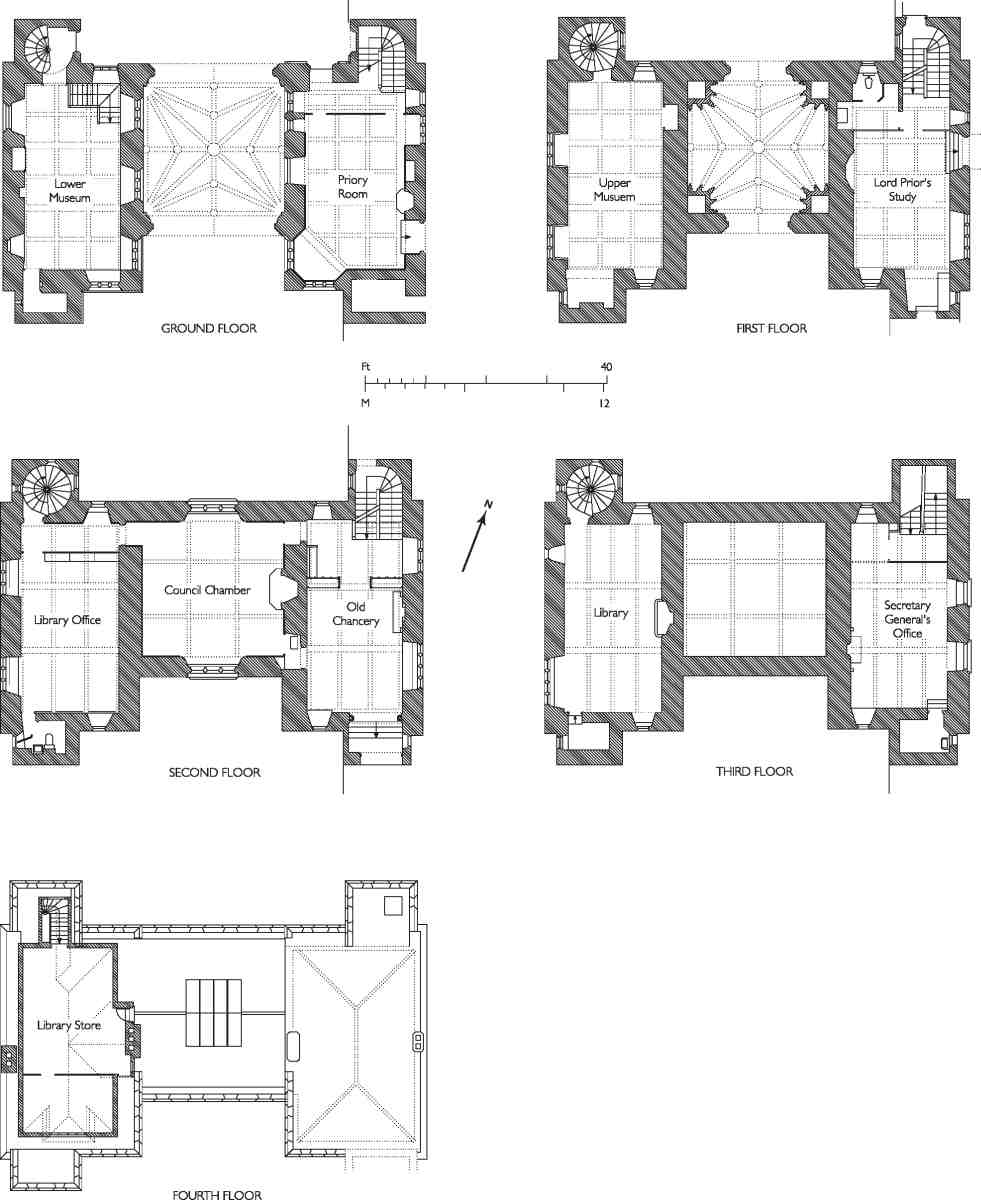
180. St John's Gate, plans in 2006
By 1682–3 the gate or more likely a part of it—probably the west tower and central hall—had been taken by Ralph Holt, a City printer. Holt often printed in partnership with others, in particular Evan Tyler, a prominent Edinburgh printer and bookseller, who was himself also based here from c. 1668 until 1682. After Holt's death in 1688 his business was carried on by his widow, Elizabeth, and then by their daughter, Sarah. (fn. 37)
By the time of Elizabeth Holt's death in 1703 the east tower of the Gate had become Hogarth's Coffee House, run by the artist's father Richard. An unsuccessful schoolteacher and writer, Richard Hogarth conceived his coffeehouse as a retreat for gentlemen to congregate and converse in Latin. Known in the 1720s as the St John's Gate Coffee House and Harvey's Coffee House, it was subsequently a tavern, connected to the adjoining house (No. 1, on the site of No. 27 St John's Square). Known variously as the Old Gate, the St John's Gate Tavern, and the Jerusalem or Old Jerusalem Tavern, it essentially retained this form until the construction of the present No. 27 and conversion of the east tower rooms for the Order of St John in the 1870s and 80s. (fn. 38)
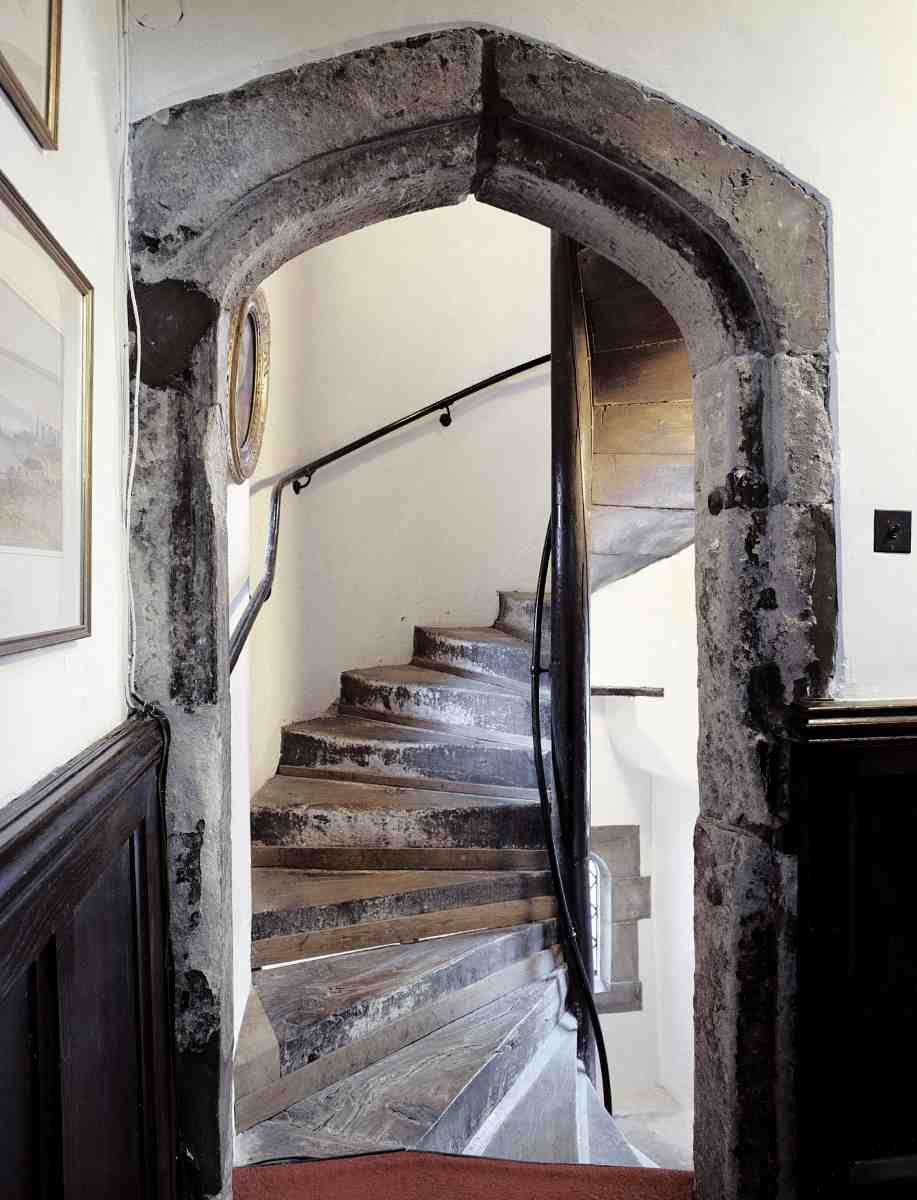
181. St John's Gate, sixteenth-century stair in west tower, in 2004
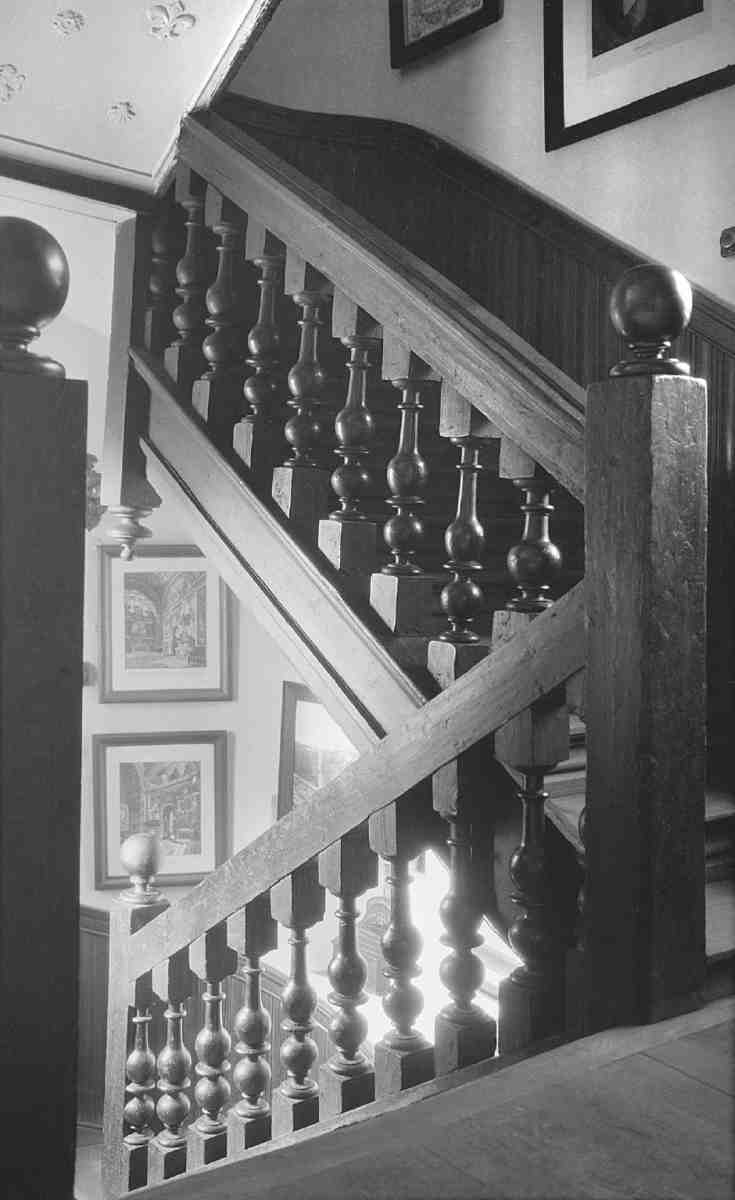
182. St John's Gate, east tower, seventeenth-century staircase in 1925, showing mid-Victorian plaster decorations to soffit
When Sarah Holt died in 1729 Edward Cave was running a printing-press in George Court (now Albion Place), on the west side of St John's Lane. By August 1730 he was settled at the Gate. (fn. 39) He had been planning for some time to produce a digest or synthesis of news, literature and opinion, and in February 1731 published the first issue of his Gentleman's Magazine. (fn. 40) Its success brought Cave into contact with a number of important writers, and the Gate became something of a focal point for literati. It also became the symbol of the Gentleman's Magazine itself, an engraved view appearing on the title-page, even for some time after production had been moved elsewhere. Cave also had its image painted on the doors of his coach, in lieu of a coat of arms.
Cave and his family lived at the Gate, presumably in the west tower, where he had a library; and Dr Johnson, who was a contributor, translator and editor for the Gentleman's Magazine in the 1730s and 40s, had a 'garret' of his own to work in. Cave's press issued other occasional magazines, and a number of books, including several works by Johnson. At first the composing and press-work appear to have taken place in the hall over the arch; in 1740 Johnson's friend Garrick gave his first public performance in London there, playing the part of Gregory in an amateur production of Fielding's The Mock Doctor, with Cave's journeymen in the minor roles. However, by 1750 a printing-works had been erected on the site adjoining the Gate to the west, (fn. 41) and it was probably around this time that the hall was appropriated by the coffee-house or tavern, which also used the room under the arch for billiards.
Cave's interests extended to matters of science and mechanics, and he was on friendly terms with Benjamin Franklin, whose Experiments and Observations on Electricity he printed at the Gate in 1751. In 1752 he erected a Franklin-type lightning conductor on one of the towers, and he also mounted four small cannon of his own design on the west tower. (fn. 42)
After Cave's death at the Gate in 1754 the Gentleman's Magazine and printing business were carried on jointly by his nephew, Richard Cave, and brother-in-law, David Henry. Richard Cave died in 1766, leaving Henry sole publisher of the Gentleman's Magazine, though he seems to have employed an agent, David Bond, to oversee its production. Bond lived at the Gate and printed the magazine in the adjoining works until 1778, when John Nichols purchased a half share, and began to transfer some of the printing to his own premises in Red Lion Passage, Fleet Street. (fn. 43) The Gentleman's Magazine ceased to be printed and published at the Gate in 1781, by which time Henry had retired to his farm in Kent.
In 1813 the ground floor of the west tower was used as a parish watch-house and the cellar beneath let for storage to Benjamin Blackmore, who had set up a brewery in the former printing-works next door. (fn. 44) The watchmen had gone by the early 1830s, their room finding new use as St John's Hospital, a dispensary to the sick poor and foreigners. This short-lived establishment was run by a 'convivial' society called the Knights of St John, which claimed recognition from the Sovereign Military Order of Malta, and was a rival body to the fledgling modern English Order of St John that was to become so closely identified with the Gate. (fn. 45) In the 1840s the room was used for storing coal, and a shoemaker's stall was tacked on outside. (fn. 46)
Changes to the fabric
While St John's Gate had found a succession of uses which ensured its survival, the fabric underwent at least four significant changes in the later eighteenth and early nineteenth centuries. First of these was the removal of the battlements some time in the 1760s, presumably because they had become unsafe (Ill. 183). (fn. 47) Then in 1771–2 the double entrance to the south front was taken down, and with it the billiard room beneath the vault. This was done by the local paving commission, not with any thought of restoring the original apearance of the gate but to aid traffic. Two masons, Joseph Brayne of Rosoman's Row and William Staines of Barbican, were paid £25 for alterations, including making good the stonework of the arch to match the north side. (fn. 48)
In the early 1800s the ground floor of the tavern in the east tower was cut away for a new entrance, the walls above being carried on iron columns and beams (Ill. 184). Finally, the lower part of the spiral staircase in the west tower was replaced with a dog-leg stair. This was possibly done in connection with the use of the cellar by the brewer Blackmore.
Rescue and restoration by W. P. Griffith, 1840s–1860s
By the 1840s St John's Gate was in a serious state of disrepair, and in 1845 it was inspected under the new Metropolitan Buildings Act, which empowered district surveyors to serve notices for repair or demolition on dangerous structures. (fn. 49) The owners, the Watson family of Bath, who had inherited the Gate from David Henry's descendants, and their head lessees, the brewers Reid & Co., were ordered to secure the crumbling masonry or pull the building down. (fn. 50)
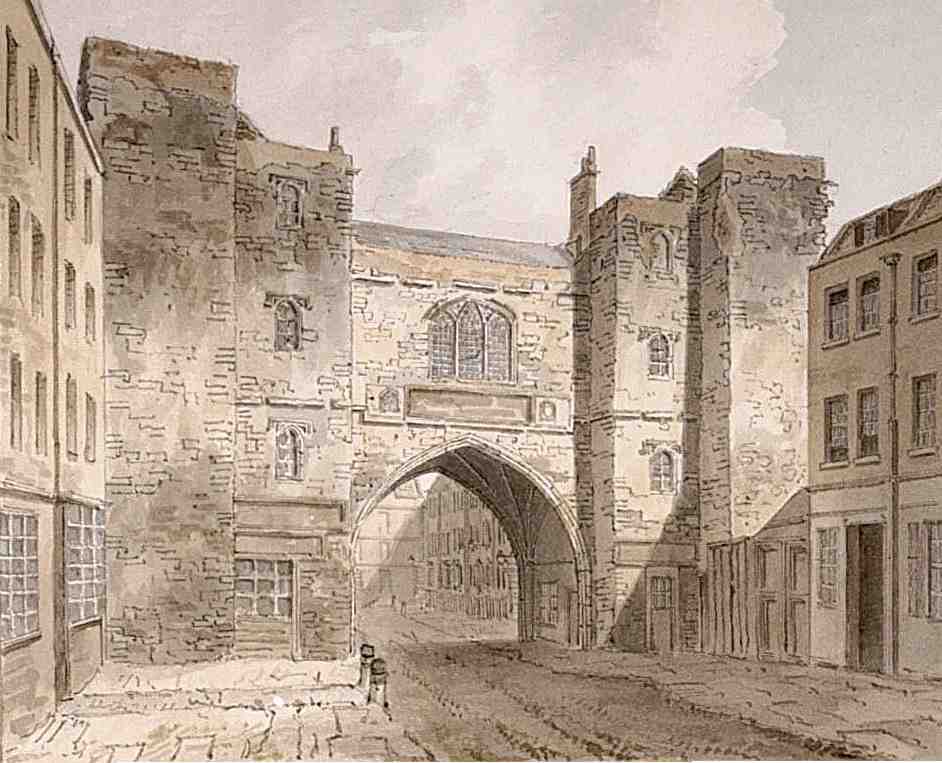
183. St John's Gate, north front in 1803, painting by J. C. Buckler
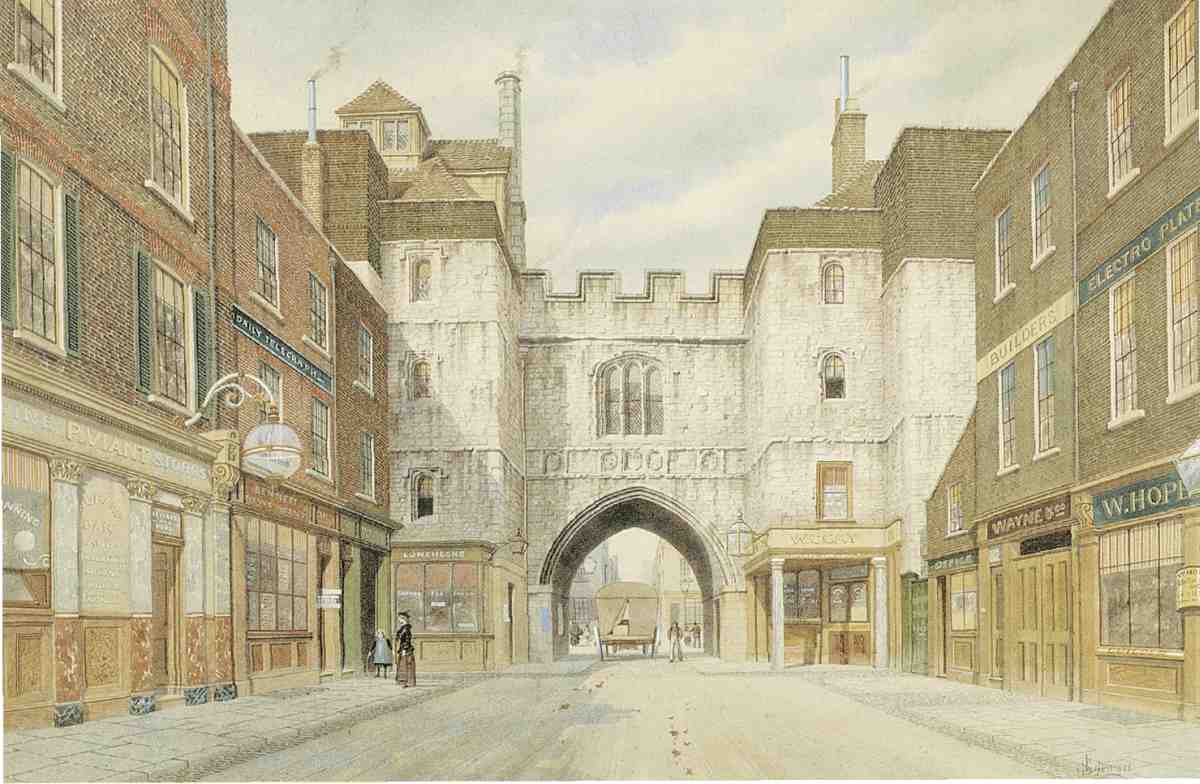
184. St John's Gate, south front, mid-1880s, painting by James Lawson Stewart. On the roof of the west tower is R. N. Shaw's extension; note also the cut-away entrance to the east tower tavern
A suggestion by Reids that, for economy, the gate should be coated with 'compo' moved the local architect William Pettit Griffith to mount a campaign to save and restore it. A resident of St John's Square, Griffith was honorary secretary to the Freemasons of the Church, a society concerned with the conservation of historic buildings and the promotion of the 'true principles and practice of architecture'. He formed a special committee of members (which included Thomas Dighton, architectural modeller to Prince Albert, the topographical artist J. Wykeham Archer, and C. H. Smith, one of the examiners of the stone used in the new Palace of Westminster) and in August 1845 launched a public appeal for funds. Reids responded by offering to repair the stone facing at their own expense, leaving the committee to use donations to effect other, more decorative improvements, such as renewing the battlements. The refacing was directed by Reids' surveyor, William Hadkinson, but the remaining work was the responsibility of Griffith, who in 1846 pub lished a print of the proposed restoration, based largely on Hollar's engraving. William Cubitt, a fellow Freemason, offered his services as contractor; Griffith later told him that the project was 'a true Masonic undertaking'.
Money was slow to come in, undermining Griffith's comprehensive scheme, and for a while restricting work to small items, including replacement window-heads. The Athenæum criticized the lack of financial support as 'remarkable in an age when the practical part of the antiquarian spirit is so widely awakened, and in a metropolis that boasts two archaeological societies'. In the end only the north front was finished, in 1846–7, to anything like the extent envisaged by Griffith, with its stone facing patched up and the battlements reinstated (Ill. 186). (fn. 51) On the south front only the central section received new battlements (Ills 184, 185).
Growing public awareness of the Gate's significance over the next two decades is attributable not only to the serious-minded Griffith, but also to the enterprising landlords of the Old Jerusalem Tavern, Benjamin Foster and his son-in-law and successor, Samuel Wickens. Exploiting the building's associations, with their 'Chivalrie Gin' and an old chair claimed to have been Dr Johnson's, they encouraged a lively literary and social life at the tavern, and Foster produced his own descriptive account, Ye History of ye Priory and Gate of St. John, published in 1851. 'Ye Grete Halle' over the arch became the meetingplace for a number of literary, masonic and pseudomedieval groups—the Knights of St John, the St John's Masonic Lodge of United Strength, and the 'The Friday Knights' (later the Urban Club). With little historic fabric visible in the room, a bogus medieval atmosphere was created with crimson velvet upholstery, 'gaudy' banners and suits of armour. (fn. 52)
Where possible, they attempted to restore or reinstate the historic fabric. Having bought the freehold of the Gate in 1866, Wickens began restoring parts of the east tower, cleaning ceilings, and decorating the seventeenth-century staircase there in 'Elizabethan style'—presumably the plaster emblems on the soffit (Ill. 182). Later that year Griffith was called in to oversee more improvements, this time to the west tower. These included the repair of the sixteenth-century newel-stair in the upper floors (Ill. 181), and the installation of the present flight of similar design beneath, replacing the early nineteenth-century dog-leg stair. At the same time the stone doorway into the stairturret was raised by some three feet, having become partly buried by the rising street level. (fn. 53)
Acquisition by the modern Order of St John
In July 1873 St John's Gate was bought from Samuel Wickens by Sir Edmund A. H. Lechmere, 3rd Bart (d. 1895). (fn. 54) This was the culmination of a lifetime's fascination with the building and its associations for Lechmere, who as a schoolboy at Charterhouse in the 1840s had given five shillings to Griffith's restoration appeal. He had become a leading figure in the growth of the modern Order of St John, becoming Secretary General in 1866–8, and had been looking for a 'nice room' in an old house in Clerkenwell as headquarters for the Order when the Gate became available. (fn. 55)
The purchase price of £9,000 included £2,000 for the public house licence and stock, as at the time the eastern half of the Gate and central hall still formed part of the Old Jerusalem Tavern. Having paid so much Lechmere could not afford simply to close it, and decided instead to put up a new tavern building on the site of the old house adjoining the Gate, so as to leave the Gate free to be gradually converted for the use of the Order. (fn. 56)
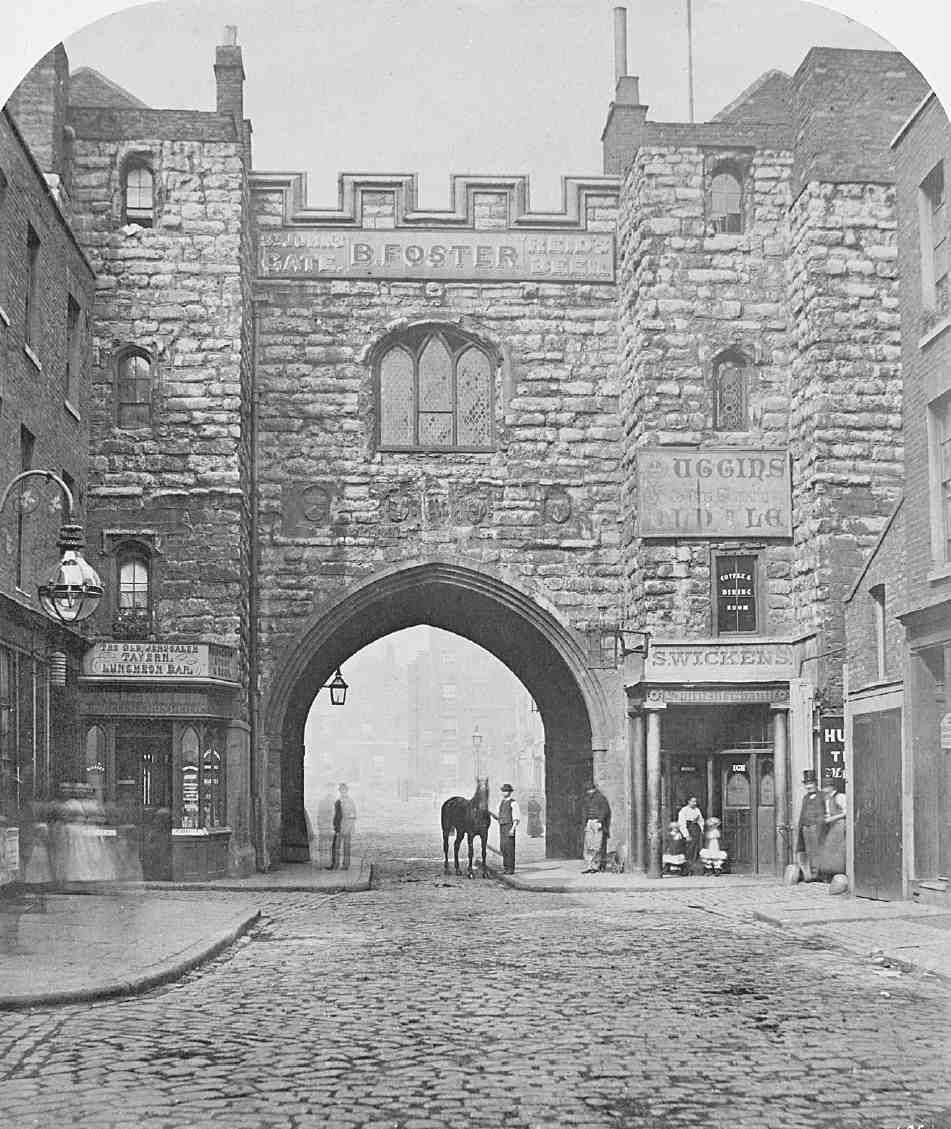
185. St John's Gate, south front, before 1873, showing battlements added by W. P. Griffith in the 1840s
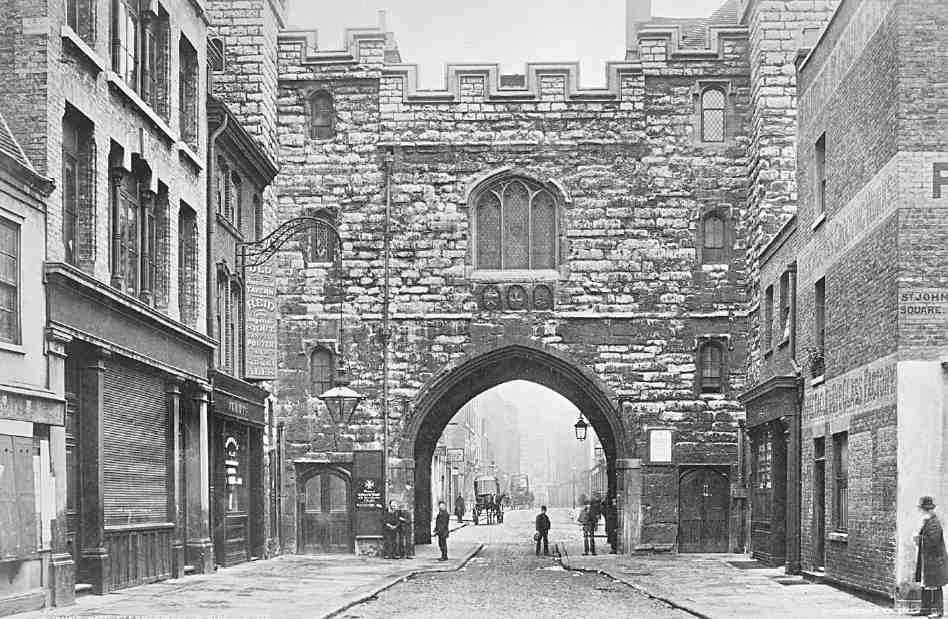
186. St John's Gate, north front, late 1880s; after J. Oldrid Scott's restoration of the Council Chamber over the arch, but before the replacement of W. P. Griffith's battlements
Lechmere regarded himself as holding the Gate in trust until the Order was in a position to buy it from him. A lease was agreed in 1879 which gave the Order an option on the freehold, and this was taken up in 1887 (through a specially formed limited company) with the help of a number of mortgage loans, including one from Lechmere himself. (fn. 57)
Alterations and additions by R. Norman Shaw, 1874–7
Lechmere first encountered Shaw as a pupil of G. E. Street, and employed him on a number of commissions, including the completion of a private chapel at his Worcestershire residence, The Rhydd Court. (fn. 58) Soon after buying the Gate, he asked him 'generally to advise and supervise' its restoration, entrusting the building 'very much to his care'. (fn. 59) One of Shaw's first tasks was probably fitting out the first-floor room in the west tower as a Chancery, ready for the first meeting there of the Order's Council in March 1874. This room is now the Upper Museum. (fn. 60)
At about the same time he restored or refurbished the top room of the west tower (now the Library), and built a new attic room above. (Lechmere had also intended that Shaw add stone battlements to the south face of the tower, to match Griffith's central section, but funds were insufficient.) (fn. 61) In the Library, the work included a new fourlight window and a stone chimneypiece with an inscription commemorating Lechmere's benefaction (Ill. 187). (fn. 62) This was perhaps the room referred to by The Times in 1876 as being restored by Shaw as a chapel. (fn. 63) The attic room (now the Library Store) is topped with a red-tile dormer roof and a neo-Tudor stone chimneystack (Ill. 184). This work was completed by 1877, when Lechmere finally offered the upper room to the Order.
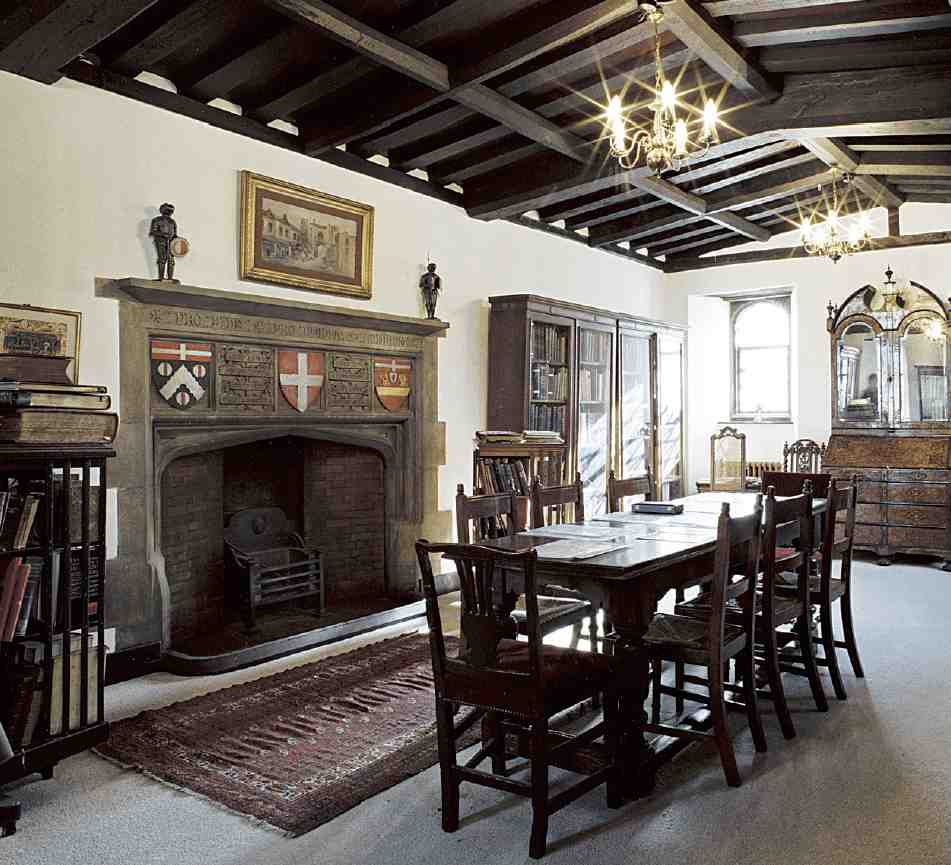
187. St John's Gate. The library in the west tower in 2004. On the left is the commemorative chimneypiece by R. Norman Shaw, 1874
While acknowledging him as a 'very clever and visionary architect' and reluctant to replace him, Lechmere was 'by no means satisfied with Mr. Shaw'. In particular, he was rarely at the Gate, even to check the progress of new work, a failing which may have been exacerbated by one of his periodic bouts of ill health. (fn. 64)
No. 27 St John Square. In 1876–7 Shaw also designed and supervised the building of the replacement Old Jerusalem Tavern for Lechmere. (fn. 65) It was later renamed the St John's Gate Tavern. The building has a simple, narrow Queen-Anne style elevation, faced with red brick in English bond (Ill. 188). Inside, it comprised ground-floor bars with living accommodation above. Now used as offices by the Order of St John, it is little altered externally, except on the ground floor where the present shopfront was inserted in 1914–15, under C. M. O. Scott's supervision, on the closure of the tavern. (fn. 66)
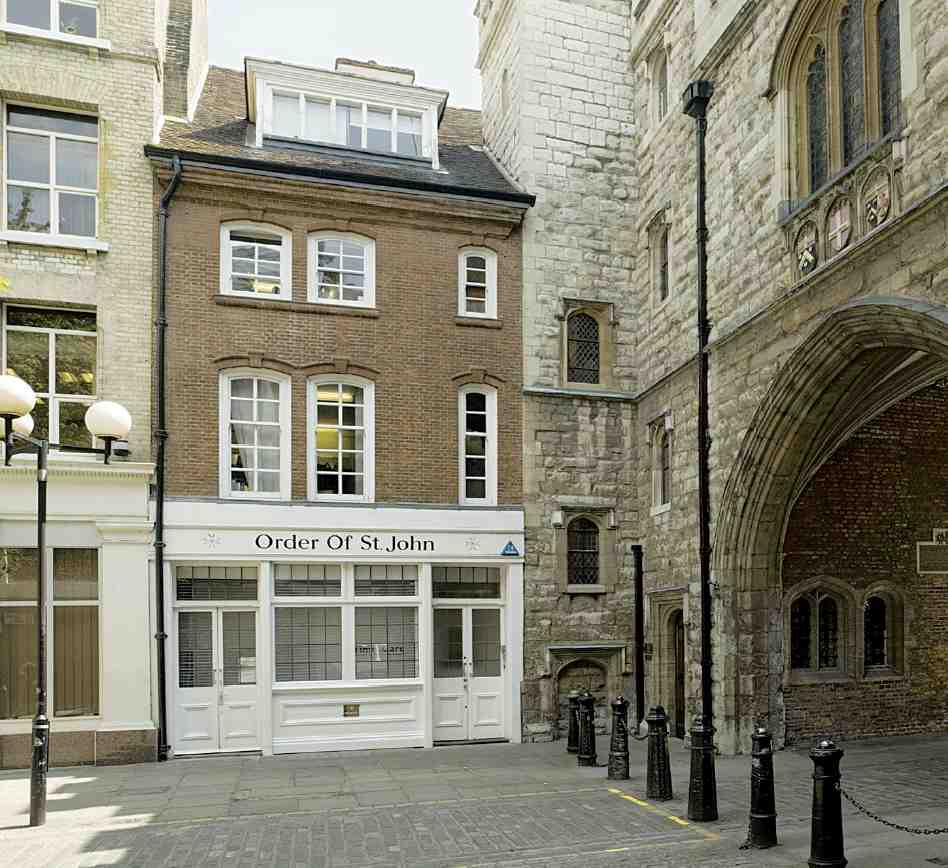
188. No. 27 St John's Square in 2006. R. Norman Shaw, architect, 1876–7
The work of J. Oldrid Scott, 1885–1903; later alterations by Scott & Son
By the time the Gate formally passed into the Order's hands in 1887, Lechmere was already engaged on another phase of restoration. On this occasion he employed John Oldrid Scott, son of Sir George Gilbert Scott, and the commission proved to be the beginning of a long relationship between the Scott family and the Order. A native of Worcestershire and MP for Tewkesbury, Lechmere was a prominent local antiquarian and had become acquainted with the Scotts through his involvement in their restorations of Tewkesbury Abbey and Worcester Cathedral in the late 1870s. (fn. 67)
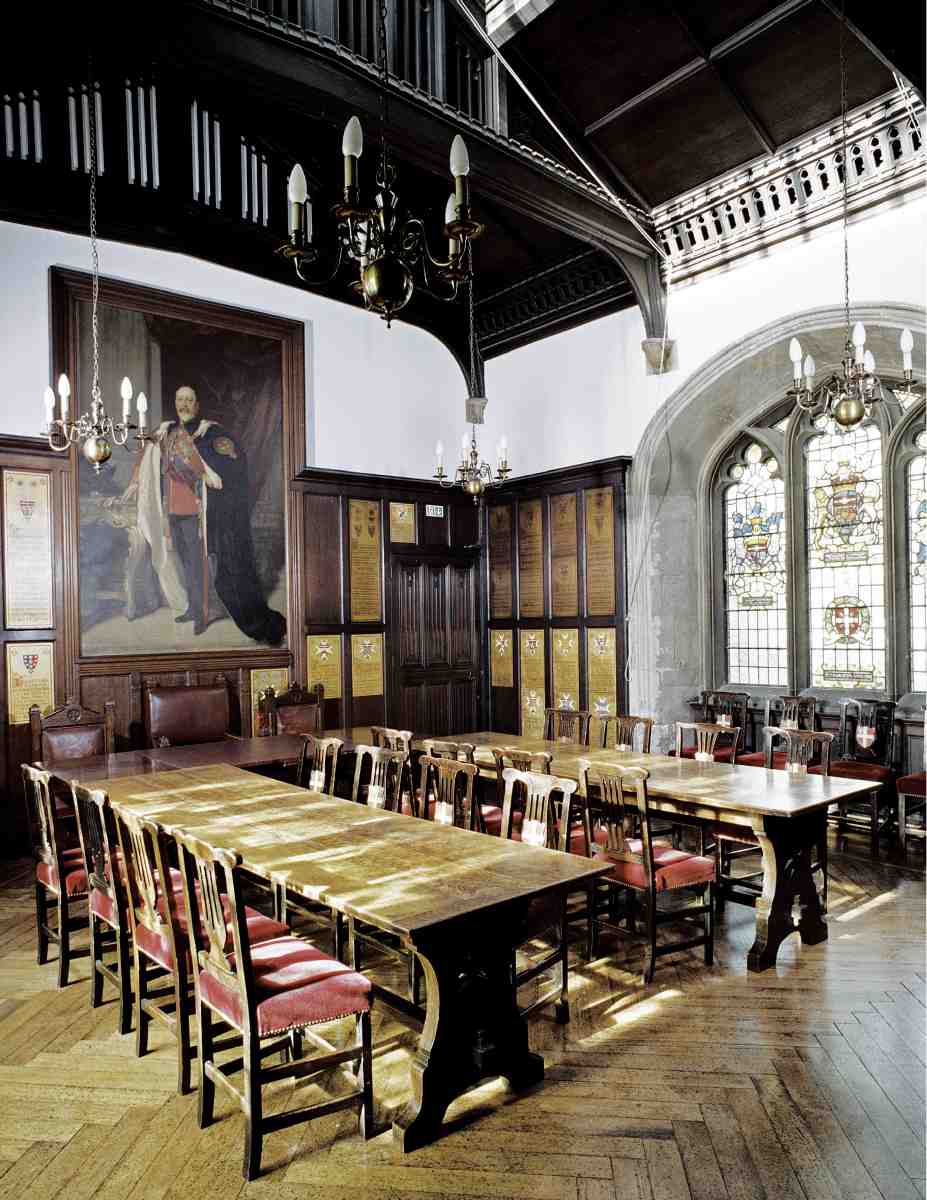
189. St John's Gate. The Council Chamber in 2004, as restored by J. Oldrid Scott, 1885–6
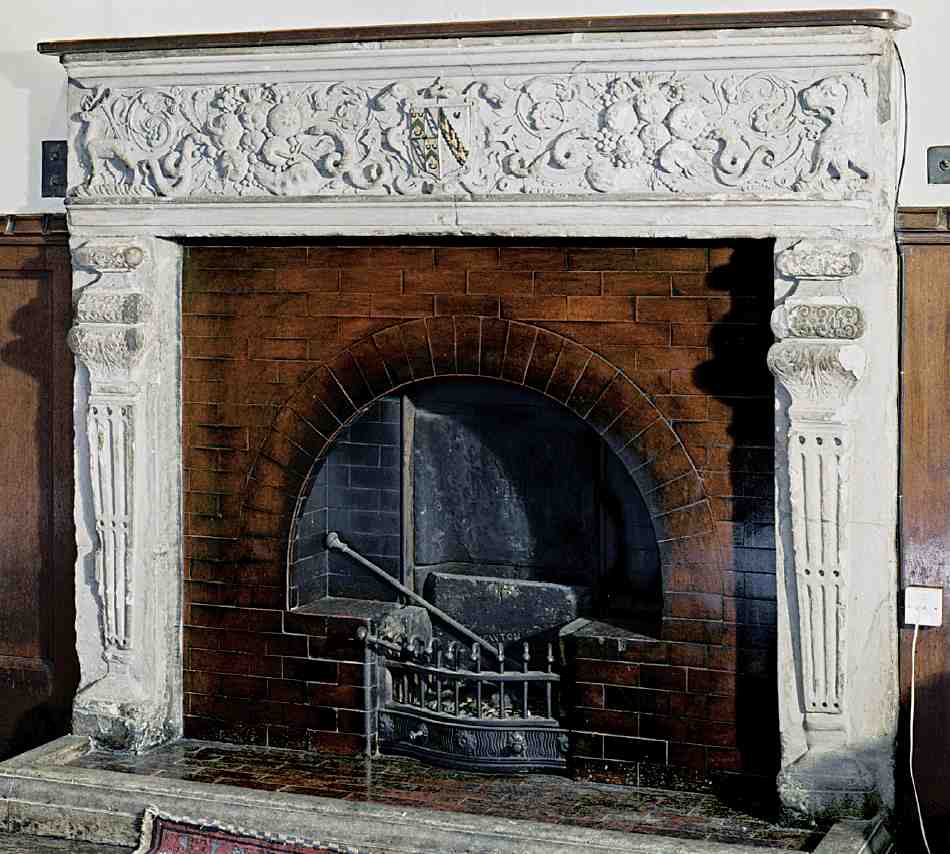
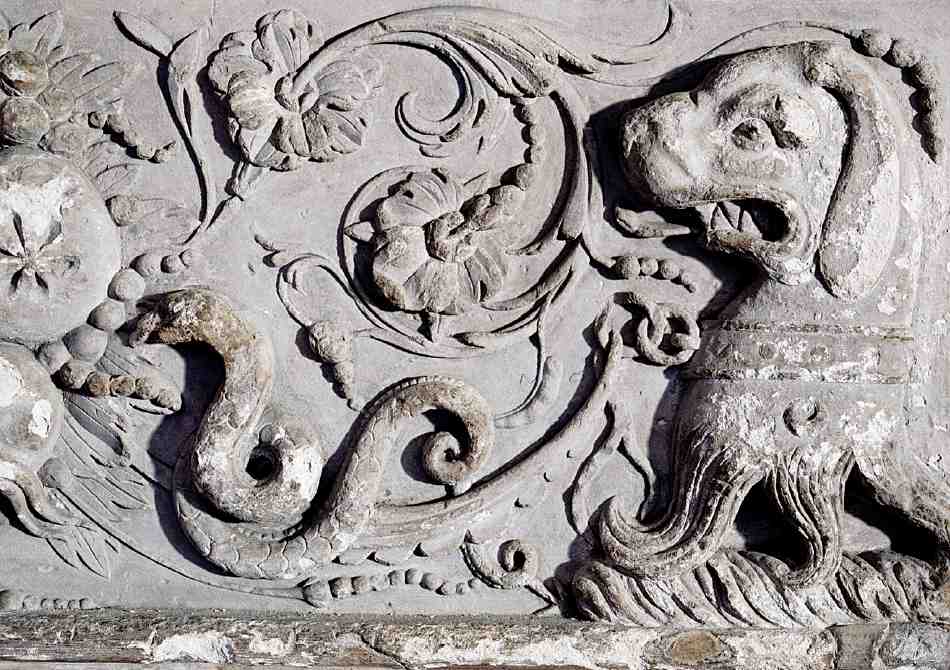
190, 191. St John's Gate, the Chancery. Sixteenth-century mantelpiece from residence of Sir Thomas Forster in St John's Lane (later the Old Baptist's Head). The central shield has the arms of Sir Thomas's family (Forster of Hunsdon, Herts) impaled with those of his wife's (Foster of Iden, Sussex). Animals at either end are from family crests
Scott had been advising on repairs and improvements since December 1881, but his first major task in 1885–6 was to remodel the Great Hall over the gateway, then recently vacated by the Old Jerusalem Tavern, as a Chapter Room. (fn. 68) He informed Lechmere in February 1885 that 'not one ancient feature' was visible internally: the stone window and door arches had been plastered over, and the windows themselves were crude, quasi-Gothic wooden frames filled with leaded lights (Ill. 185). (fn. 69) Scott's chosen style—a sombre, heavy, interpretation of Tudor Gothic, with stained oak panelling, bare stone arches and Perpendicular tracery—set the tone for the entire restoration programme, carried out by him and his son C. M. O. Scott over the next thirty-odd years. The room, now the Order's Council Chamber, remains largely as refitted to Scott's designs by John Thompson of Peterborough and Farmer & Brindley (Ill. 189). Its principal feature is an open-timbered roof and lantern. A high panelled wooden dado incorporates two large royal portraits, and is brightened considerably by gold-painted memorial panels. The heraldic glass in the windows, by Powells of Whitefriars, was intended by Scott but not installed until 1910–11. (fn. 70)
The east tower having been vacated by the tavernkeeper in 1887, Scott was free to embark on a comprehensive refit and redecoration there. (fn. 71) The rooms were already partitioned, and, for economy, he seems to have retained much of the existing layout, adapting it to suit the needs of the Order. Only the seventeenth-century staircase and the oak ceiling of the top room were, in his opinion, of good design. (fn. 72) His biggest job was to restore the ground floor, where the wall had been cut away, for use as a library. Leaving the iron column at the corner in place, he rebuilt this in brick, faced with stone to match the rest of the building, with two three-light windows. Thompson had completed the work here by April 1890. (fn. 73)
Throughout the tower Scott proceeded as he had in the Council Chamber, retaining or revealing older fabric where possible, such as ceiling ribs or window- and door-surrounds, and installing new windows, floors and panelling. The second-floor Chancery (formerly the Secretary's office), which communicates with the Council Chamber, retains its pre-Scott ceiling. The carved stone mantelpiece here, of c. 1570, came from the house of Sir Thomas Forster in St John's Lane, later the Old Baptist's Head public house. It was installed in 1895 when the pub was rebuilt (Ills 190, 191). The carved screen dividing the Chancery from the staircase lobby is a later design by Scott & Son, installed by Thompson in 1912. (fn. 74) On the third floor, in the Secretary General's Office, Scott kept the existing low-pitched ceiling with its exposed roof timbers. The panelled partition and tiled fireplace in this room were added by C. M. O. Scott in 1915–16. (fn. 75)
The greatest challenge was the restoration of the exterior stonework, which was badly decayed despite the restoration of the 1840s. Scott suggested a complete overhaul, paring away additions and alterations—including Griffith's battlements—and rebuilding in a more robust manner, retaining as much original stonework as possible. Three-light windows were inserted in the ground-floor room of the west tower (now the Lower Museum), replacing the old shopfronts there, and stone dressings were applied to any windows not already restored; the groining of the arch was also repaired. Chilmark stone from Wiltshire was used for the facings, being similar in texture to the original firestone, with Kentish rag and Bath stone for window surrounds and dressings. The work was carried out by Thompson in 1892–5. (fn. 76)
Scott's restoration drew some criticism at the time. A letter-writer to the Echo complained in May 1893 that the Gate was being 'tinkered and transformed' by 'vandals', and when finished would 'wear a Tower-bridgy … sort of look'. (fn. 77) Baron Amherst of Hackney, a senior figure in the Order of St John, confided to a correspondent in September 1892 that he found Scott's work on the exterior of the south-east tower 'poor and meagre in design', going on to say that unless Scott was willing to 'express in his new work the entire feeling of the old I should feel justified in choosing another architect'. (fn. 78) But in general the restoration was well received, and deemed a fitting memorial to the Duke of Clarence and Avondale (d. 1892), the late Sub-Prior of the Order, whose arms were included in a new set of shields and inscriptions on the south front. Along with the Royal arms and those of the Prince of Wales and Prior Docwra, these replaced the decayed original carvings. (fn. 79)
Of later alterations by Scott and his son the most important was the partitioning of the northern end of the second-floor Library in 1913–14 to make a passage linking the west tower staircase with the Council Chamber (see Ill. 180). At the same time the room so formed (now the Library Office) was fitted out with new oak panelling and bookcases, and the plaster removed from the stone stairwell arch. (fn. 80)
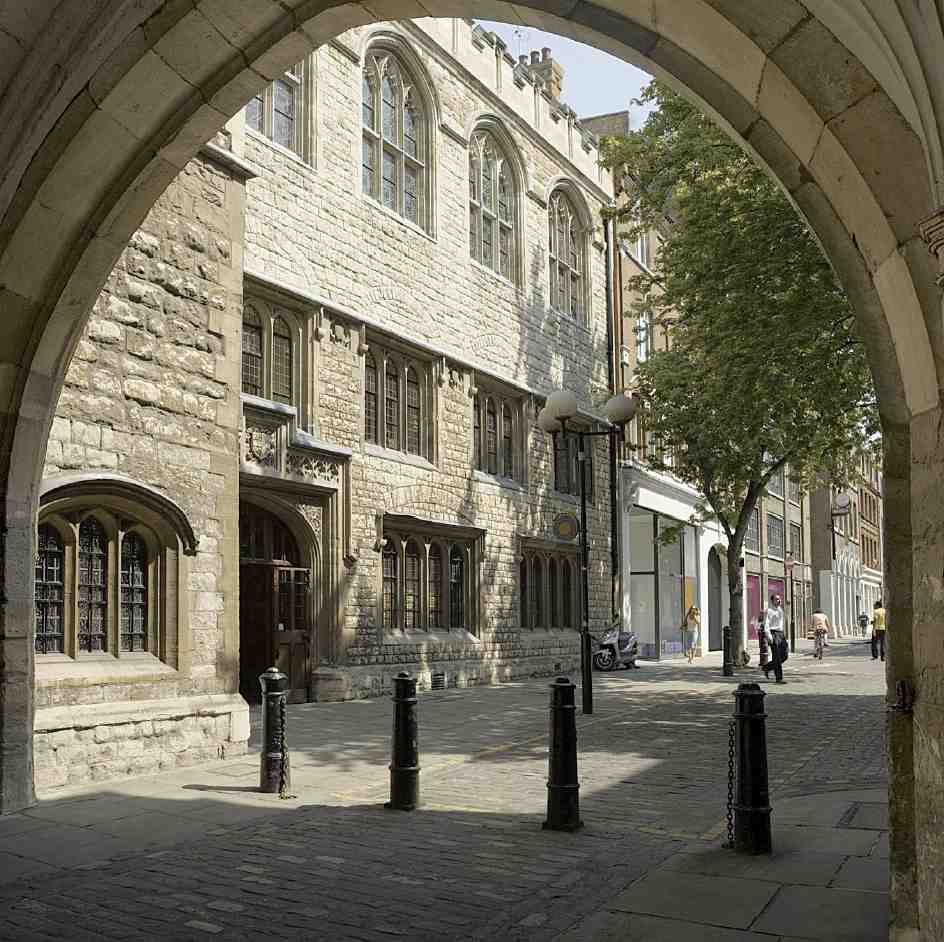
192. St John's Gate. Chapter Hall extension in 2006. J. Oldrid Scott, architect, 1899–1903
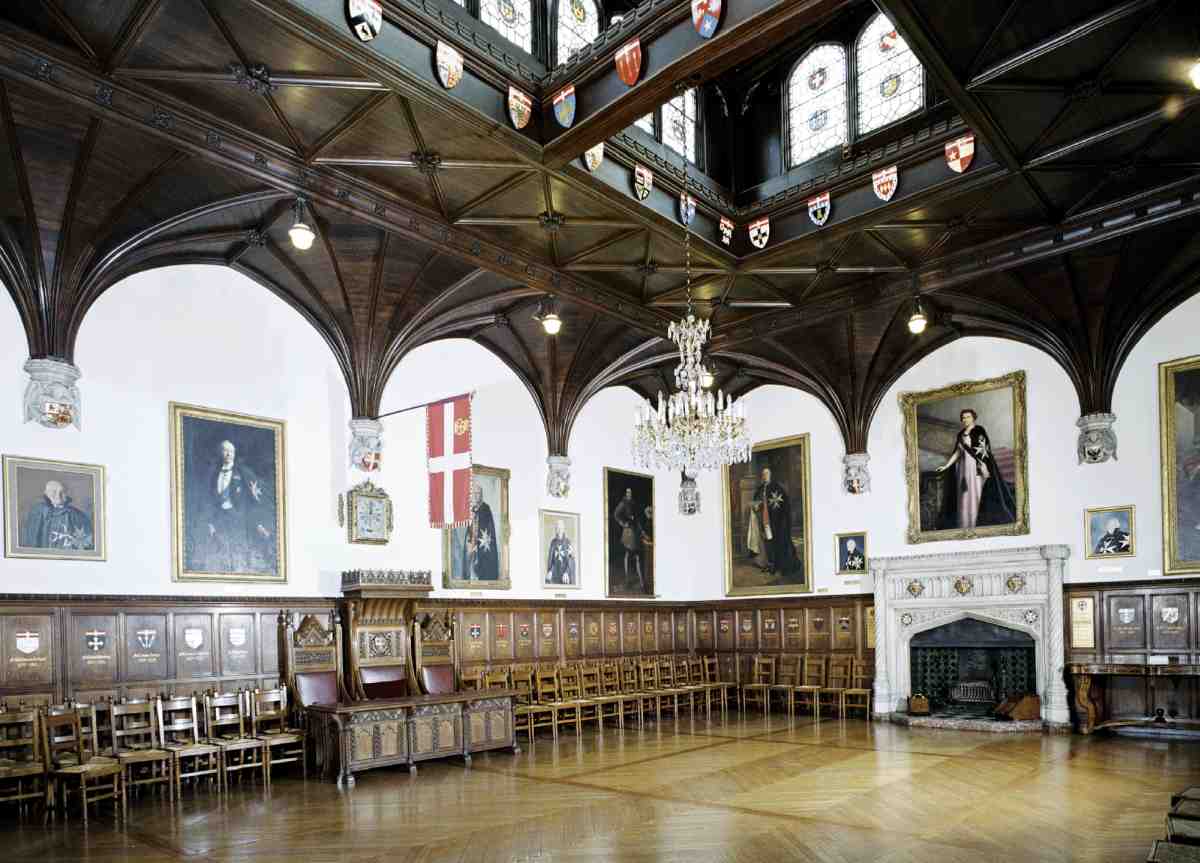
193. St John's Gate. Chapter Hall, looking south, in 2004; J. Oldrid Scott, architect, 1899–1903
Scott's final work at the Gate was the extension in St John's Lane, partly for the St John Ambulance Association and Brigade but including a grand hall for functions and meetings of the Chapter-General, the Order's governing body. Completed in 1903, this was built on a site acquired in 1888, when an ambulance garage, stabling and a flat for rent had been built on a small piece of Clerkenwell Road clearance ground east of the Gate: the building, with a tall, red-brick front to St John's Lane, partly tile-hung, was designed by Robert Vigers, a surveyor active in the Order. (fn. 81) A much larger piece of ground to the south was bought from the provision merchants Lovell & Christmas that October, but remained undeveloped until Scott's recall to design a building for the site in the late 1890s. (fn. 82)
Vigers' building was largely demolished, although the stables and hay-loft, tucked away at the side of the Gate itself, appear to have been retained. Scott's three-storey extension provided storage space and a showroom for ambulances and wagons on the ground floor, offices and a lecture room or drill hall on the first floor. Occupying the whole second floor was the Chapter Hall. (fn. 83)
Externally, Scott followed the style of the restored gatehouse, with ragstone facings, traceried windows for the hall, and a battlemented parapet. The large carriage gateway, now the principal entrance to the Gate, has a four-centred arch with a squared hood-mould and spandrels with carved foliage (Ill. 192).
Inside, the chief interior is the oak-panelled Chapter Hall, which has an imposing ceiling, rising from a series of fan vaults, all executed in oak and with a large lanternlight (Ill. 193). Both panelling and lantern are ornamented with painted shields and armorial bearings, mainly of the priors of England. There are five large Perpendicular windows, four in the west wall and another in the north. A door in the north wall connects the hall to the Gate via the second-floor Chancery.
Proposed new headquarters for St John's, 1928–51
In the late 1920s, as the work of the St John Ambulance Association and Brigade increased, it was decided to build a new headquarters on the west side of the Gate. The site, a rectangle with frontages to St John's Square and St John's Lane, had been acquired piecemeal since 1901 as part of an aspirational strategy to 'restore' the old priory precinct and preserve the vicinity of the Gate against unwelcome redevelopment. (fn. 84) The intended first phase was planned to coincide with the Order's centenary in 1931. (fn. 85)
Architects including Sir Herbert Baker, Basil Champneys and Gordon Jeeves were invited to make submissions and in 1930 four were selected to take part in a limited competition, with Sir Aston Webb (a member of the Order) advising and Sir Reginald Blomfield as judge. (fn. 86) The names of only two competitors are known: H. S. Goodhart-Rendel, whose imaginative but unsuccessful designs survive; and Frederick Etchells, whose plans were accepted (Ills 194, 195). (fn. 87)

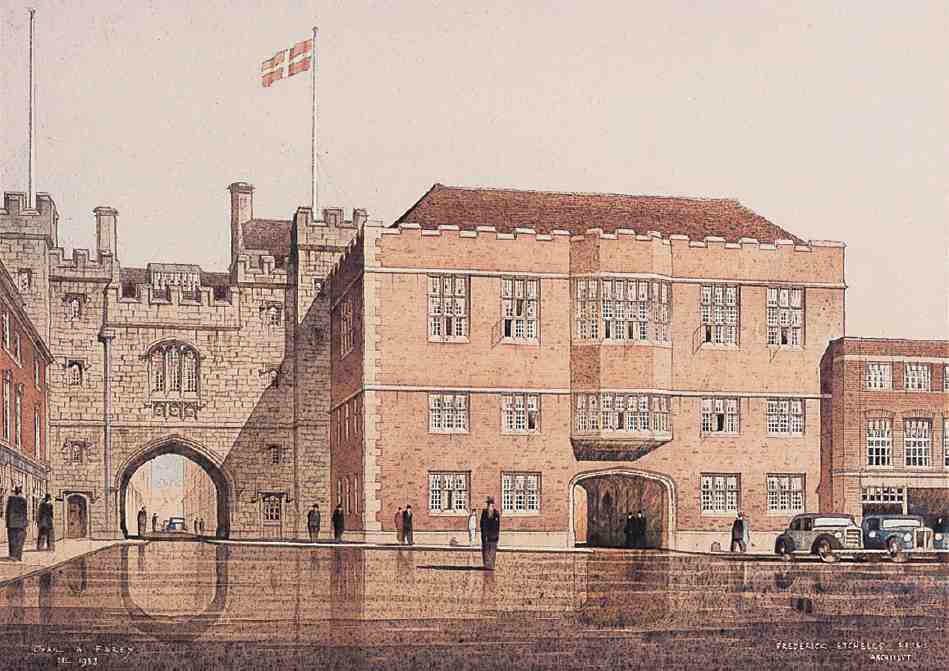
194, 195. Proposed new headquarters for Order of St John. Design by H. S. Goodhart-Rendel, 1930, and (below) winning design by Frederick Etchells (an artist's impression by Cyril Farey, 1938)
Whereas Goodhart-Rendel had devised his asymmetrical building to serve as a 'foil' to the historic gatehouse, Etchells chose to match it with a sanitized neo-Tudor structure, which repeated some of the Gate's principal features, notably the central archway and battlements. Beneath the facing of handmade brick and Clipsham stone would be a modern steel frame, encased in concrete. An architect at the Office of Works later described the proposal as a 'very feeble effort'. (fn. 88) It would, had it been completed, have been Etchells's biggest and most important commission in the capital.
Existing leasehold interests had been acquired and much of the site cleared by 1939, and work began on the first portion of the new buildings. (fn. 89) The revised design approved by the London County Council comprised offices and meeting-rooms, including a wood-panelled Chapter Hall and Council Chamber, in three ranges around an open court, linked both to the Gate and a stores department on Briset Street. An extensive basement, some 11 ft deep beneath the courtyard, was to provide additional storage space. (fn. 90)
Only the basement had been completed by 1940 when the war brought work to a halt. During the hostilities this served as a public air-raid shelter and after the war was used by the Order for bulk storage. The headquarters scheme was finally abandoned in 1951, reinstatement of the bombed St John's Church taking up all available resources. By this date too there was less need for new office space in Clerkenwell, as the Order had retained premises in Grosvenor Crescent, where it had been based during the war so as to be near the Red Cross. (fn. 91)
In the winter of 1954–5, with restoration of the church about to begin, it was decided to let the site of the aborted headquarters for building, along with the adjoining stores site on Briset Street. Priory House (page 162) now occupies the site.
Changes since 1935
In 1935 a museum was established in the basement of the west tower, the floor being lowered some 3 ft to accommodate it. (fn. 92) Since then the museum, and the associated library and archives, have expanded to occupy most of the original Tudor gatehouse and parts of the adjoining buildings.
Of various internal alterations since then, the most important was the creation in 1964–5 of a new main entrance in Scott's Chapter Hall wing, in what had previously been the stable-yard, to cater for the large number of guests attending receptions. The work, carried out by Dove Bros, was designed by the firm of Seely & Paget, who had been appointed architects for St John's Gate in 1951 (Seely, otherwise Lord Mottistone, died in 1963). Plate-glass doors replaced the old stable swing doors, and a new Portland-stone floor was laid on the forecourt, with the badge of the Order inlaid in black marble. Scott's iron staircase balustrade was boxed in (the boarding has since been removed), and the walls of the hall, staircase and a new robing-room adjoining were lined with sapele veneer; this last improvement was suggested and paid for by a member of the Order, Leander McCormick-Goodhart. At the same time a dining-room was provided for the Lord Prior, and the office accommodation improved. (fn. 93)
St John's Lane. East Side
Nos 35 and 36–37 at the south end of the lane, originally three separate houses, are the only pre-Victorian buildings left. They are of indeterminate date, Nos 36–37 probably of the late eighteenth century (a parish boundary plate dated 1797 is set in the wall), No. 35 more likely of the early nineteenth century.
No. 27 (with Nos 89–97 St John Street)
Between 1999 and 2001 the two red-brick Victorian buildings at No. 27 were extended and entirely recast, along with Nos 89–97 St John Street, as part of a mixed-use redevelopment by Damond Lock Grabowski Architects (DLG). Formerly numbered 26 and 27, they were erected in 1887–9 as part of a development by Lovell & Christmas of Smithfield, food importers and provision merchants. The site—Clerkenwell Road clearance land to the north, old houses and warehouses to the south—was bisected by Passing Alley, which was moved some 40 feet to the south end of the ground, widening it in the process. (fn. 94)
Of the two buildings, the southern contained the entrance to a large and irregularly shaped plot extending to St John Street, where another street-front building was erected, now No. 89; two more were added later, in 1895 and 1900–1, at Nos 97 and 91 St John Street respectively. (fn. 95) The bulk of the site, between the two streets, was taken up by stabling (for 60–70 horses), garaging and basement cold stores. The street-front buildings provided offices and living accommodation for employees. (fn. 96) The taller but otherwise much smaller northern building (formerly separately numbered 26) was built as a shoeing forge and smithy, with living accommodation over, and let to the United Horse Shoe & Nail Co Ltd. (fn. 97) All the buildings were of red wirecut and rubbed brick, with some terracotta and stone, in a simplified Queen Anne Revival style (Ill. 197); the architects were 'Messrs Beaumonts'—probably Eugene C. Beaumont and his sons, of Ludgate Circus, or less likely the Manchester architects James William and Richard Fletcher Beaumont, who also had a London office at this time. (fn. 98) Surviving original details include horse-head decorations on the old forge fascia and incised lettering: the name of Lovell & Christmas (over the former cartway) and 'PASSING ALLEY' at each entrance to the footpath (Ill. 196).
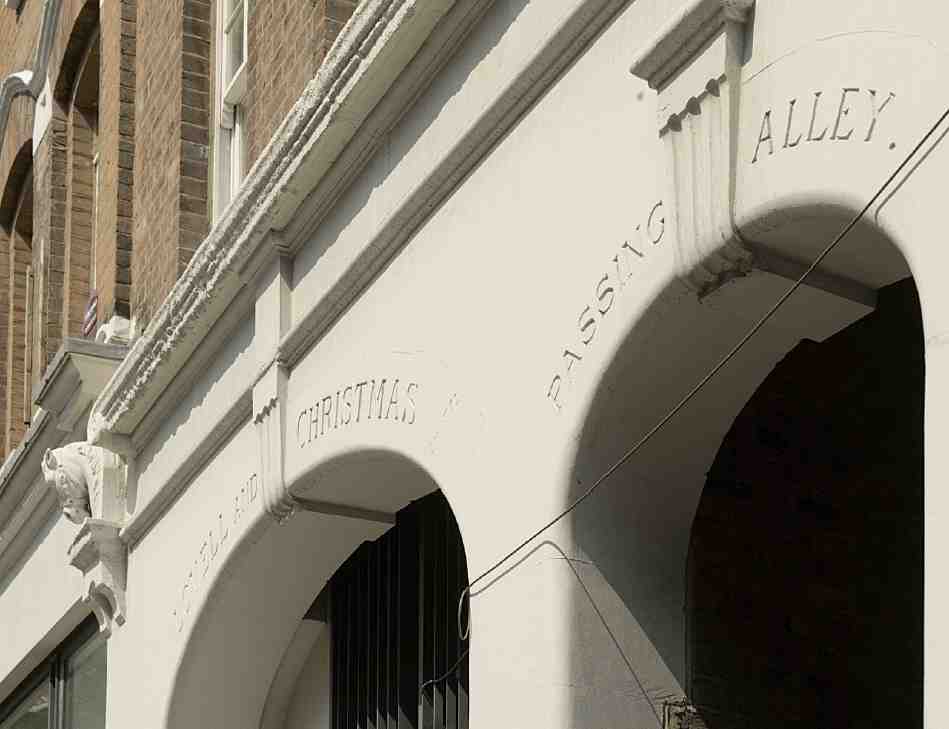
196. No. 27 (formerly 26 and 27) St John's Lane. Detail of cartway and entrance to Passing Alley, 2006
By the 1930s the stabling at No. 27 had been converted to garages and workshops. The adjoining forge remained in use until 1939 when it, too, became garaging space, for St John ambulances, with flats above. (fn. 99)
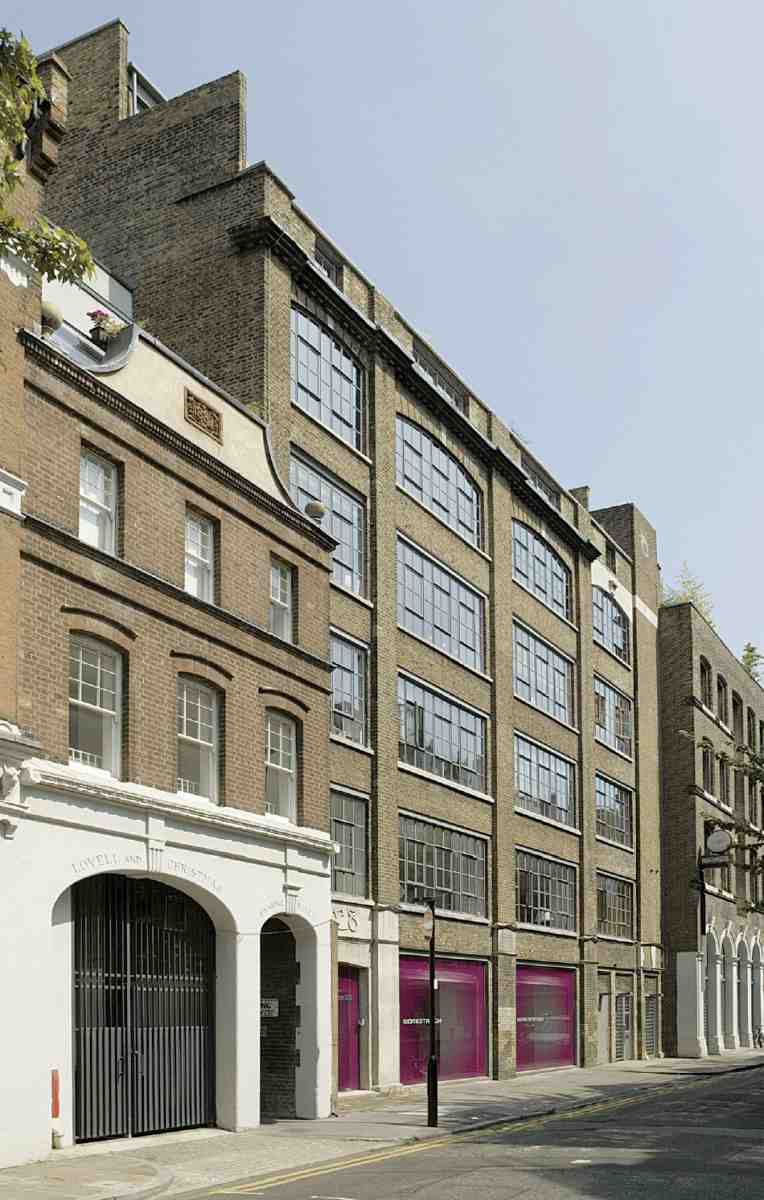
197. Nos 27–29 St John's Lane in 2006
The recent redevelopment saw an almost entirely new structure rise behind the retained façades, comprising flats, offices and new headquarters for the St John Ambulance Association, connected to its former home at St John's Gate. The energy-efficient design includes a glazed central atrium providing natural cooling and ventilation, and concrete walls left bare to absorb moisture from the air (Ill. 198). (fn. 100)
Nos 28–29 (with Nos 75–77 St John Street)
This site comprises former warehouses, differing somewhat in scale and style, erected by Fenner Appleton & Co., wholesale manufacturing stationers, whose precursors were established on the site from the mid–1860s. The earlier range, numbered 29 St John's Lane and 75–77 St John Street, was built in the early 1880s. (fn. 101) These were conventional warehouses of stock brick with timber floors supported by cast-iron columns, though only No. 29 is still immediately recognizable as such. The architect was probably Herbert D. Appleton, a family member who later adopted his wife's surname of Searles-Wood, and who subsequently carried out various alterations and additions here. (fn. 102)
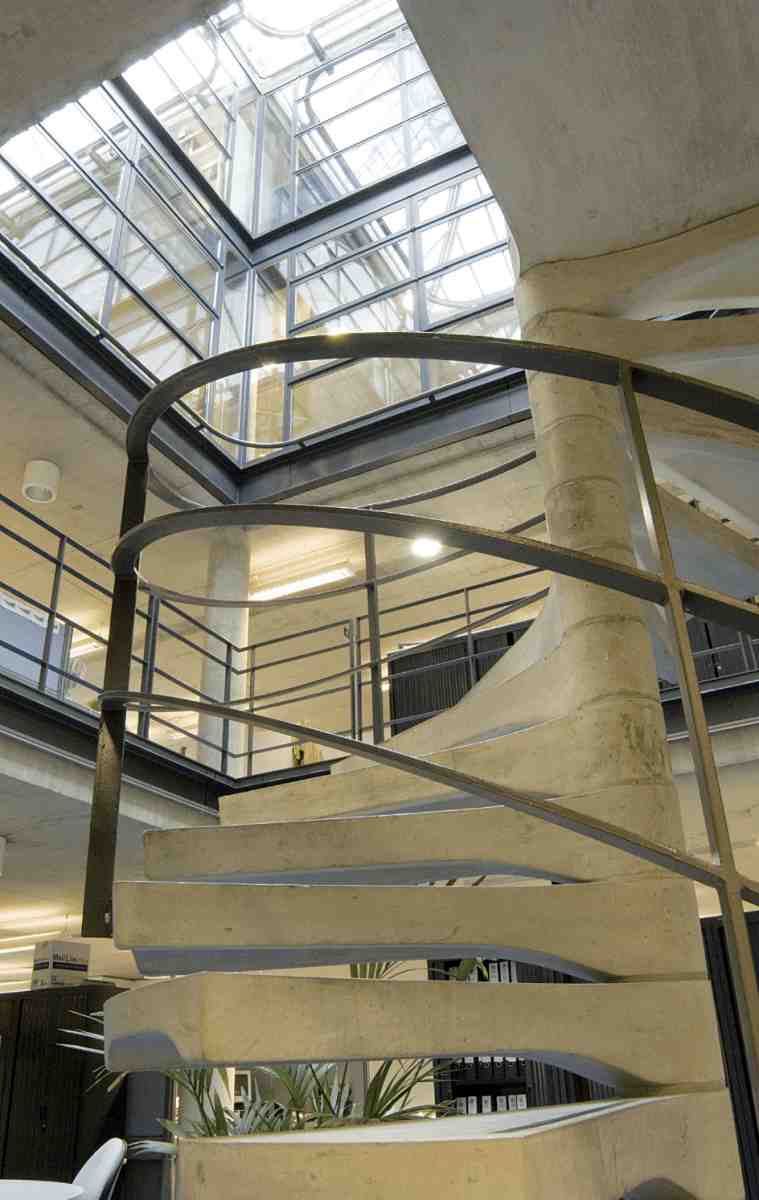
198. No. 27 St John's Lane, offices of St John Ambulance. Atrium in 2004
About 1899 the firm acquired the freehold of a former timber yard at No. 28, and within two years had erected there a second, more extensive building to Searles-Wood's design. Although very different elevationally from its neighbour, with rows of large rectangular window openings (Ill. 197), it was structurally similar. (fn. 103) In its present form the building is a partial reconstruction of 1918–19, having been re-erected (along with No. 77 St John Street) after damage inflicted by an air-raid in December 1917. (fn. 104)
In 1997–2000 both warehouses were converted to offices and flats by Herber-Percy & Parker Architects, as part of a mixed-use development which included a new building on an adjoining car park at Nos 81–87 St John Street. The new apartments at No. 29 included a duplex penthouse priced at the then very high price of over £1 m. (fn. 105)
No. 30 (former Old Baptist's Head public house)
The inn that stood here until the 1890s originated as part of the sixteenth-century mansion of Sir Thomas Forster (see above), but seems to have been partly rebuilt and much altered in the early 1820s (although it retained a stone mantelpiece since removed to St John's Gate, see Ills 190, 191). A view of the lane in the 1820s by R. B. Schnebbelie shows the rebuilt Baptist's Head, 'shorn down and stuccoed to the unmeaning aspect of a place that might have been erected any time within the last fifty years', as Pinks, the local historian, lamented in the 1850s (see Ill. 176). (fn. 106) The present red-brick former pub was erected in its place in the 1890s and was converted to a warehouse about 1961. (fn. 107) Since 1970 it has been owned by the Post Office Superannuation Fund, and is now fitted out as offices for small businesses. (fn. 108)
Peel Court Meeting-house (demolished)
From 1655 until 1926 a congregation of Quakers met in St John's Lane. (fn. 109) One of the early London meeting-places of the Society of Friends, the original site was a carpenter's workshop and yard called the 'Peel' or 'Baker's Peel', in reference to the long-handled bakers' shovels manufactured there. Initially the meeting was small—about 16 were attending weekly in the 1660s—and was a target for persecution by the justices, perhaps because of its proximity to the Sessions' House in St John Street (Hicks' Hall).
By 1722 the 'old patched building' used for gatherings had been demolished and a new meeting-house erected on an enlarged site by John Jennings, a member of the Society. This house, which occupied the core of the site until its destruction in 1940, was a lofty, square building, originally facing west on to a small forecourt off St John's Lane; inside it was 'devoid of ornament', with a gallery supported on square piers.

199. Peel Institute, St John's Lane. Christmas party in the old Peel Court meeting-house, mid–1920s
In 1789 the Friends enlarged the site by acquiring property adjoining to the north and east, and made an entrance from St John Street to a court (Peel Court), north of the meeting-house. The windows facing St John's Lane were bricked up, the ceiling was raised and the gallery piers replaced by slenderer columns. Two houses (later numbered 65 and 67 St John Street) with an archway had been built at this entrance by 1811, and in 1819 a caretaker's house and outbuildings were erected within the court (see Ill. 175).
In 1895–6 the property was largely redeveloped. The meeting-room itself was partially re-constructed, with the gallery extended around three sides (Ill. 199). A mission room and coffee-house (No. 31 St John's Lane) were built next door, and Nos 65 and 67 St John Street were rebuilt. (fn. 110)
Peel Court Meeting was discontinued in 1926 and the buildings let to the Bedford Institute Association, a Quaker society concerned with social work in East London. From 1928 they were used principally as meeting-rooms and a gymnasium by the Peel Institute, an affiliated sports and religious club, formerly based in Clerkenwell Green. As part of a redecoration of the buildings in 1928–9, students from the Slade School of Art were asked to paint a mural in the old meetinghouse. Like Rex Whistler's earlier scheme at the Tate Gallery restaurant, this was partly funded by the art dealer Sir Joseph Duveen, who by encouraging 'young men of promise' to execute decorations in public buildings hoped to create a British school of mural painting. (fn. 111) Unfortunately, no record of the paintings survives. In September 1940 the entire premises were destroyed in an air-raid. Today the site is occupied by Watchmaker Court (No. 33 St John's Lane), an office development completed in 1992 to designs by IKA Project Design & Management, which includes new buildings at Nos 65–67 St John Street and the refurbishment of No. 55.
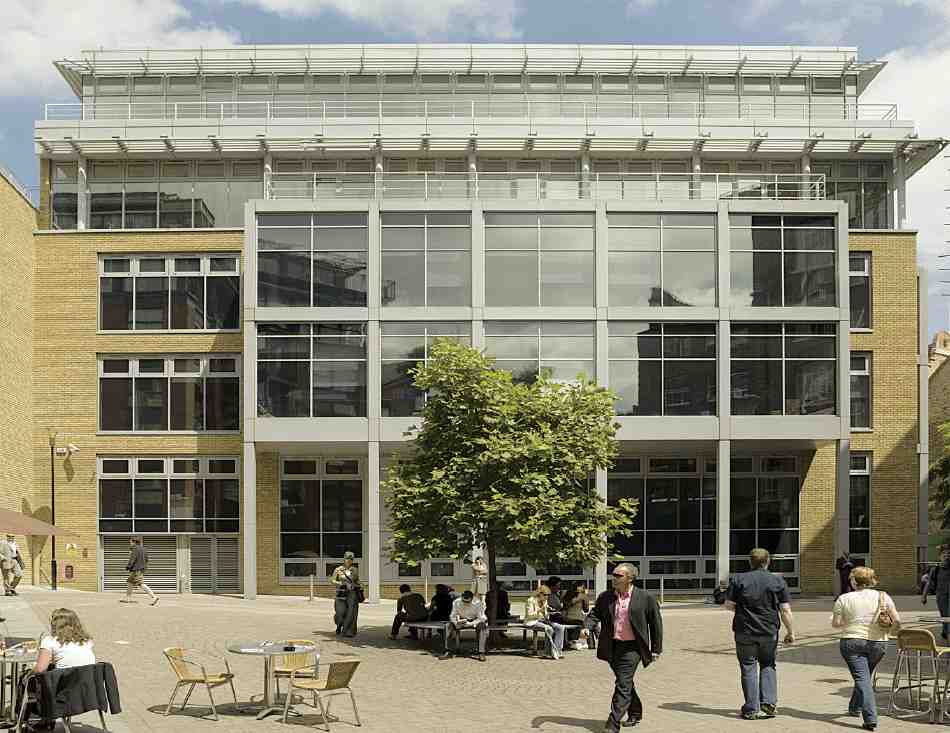
200. Exchange Place, No. 1 St John's Lane, in 2006. The Thomas Saunders Partnership, architects, 2001
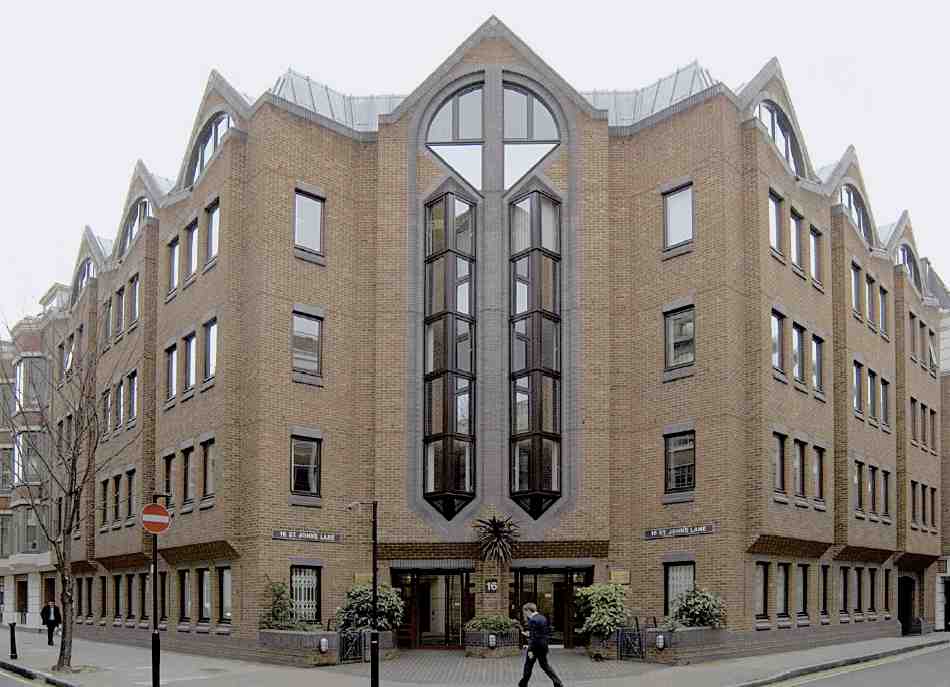
201. No. 16 St John's Lane in 2007. EPR Partnership, architects, c. 1987
West Side
Office developments since c. 1960
The southern corner here is now dominated by Exchange Place at No. 1, on part of the former Danish Bacon site, completed in 2001 by Kier London for Bee Bee Developments Ltd (Ills 174, 200). Designed by The Thomas Saunders Partnership (TTSP), the building was constructed on a wide-span concrete-frame, supported on a reinforced concrete raft, providing over 90,000 sq. ft of office space on 7 floors. Set within a public 'piazza', the development has involved reconfiguration of the streetpattern here, behind Cowcross Street. (fn. 112)
Immediately to the north are three smaller late twentieth-century developments, each typical of its date: No. 5, of the 1970s, clad in dark brick and tinted glass; Nos 6–7, red-brick and stone offices of 1989–91, postmodern in style; and No. 8 (formerly 8–11), with a characteristic 1960s front banded horizontally with metal-framed windows and buff brick panels. This last, designed by Maurice Sanders Associates as a warehouse, was later converted to offices, occupied in the late 1980s and 90s as the headquarters of the stationers John Menzies. (fn. 113)
Between Albion Place and Briset Street are two office developments dating from the late 1980s, each with a return frontage and a prominent corner entrance. Both were set back from the previous building line to allow for widening in St John's Lane and the side streets, and both seem to hark back to the Tudor mansions which once lined this side of the lane. The upper storeys of No. 14 (Knights Quarter) are composed almost entirely of giant bay windows, while No. 16 (formerly 16–21A), by the EPR Partnership, which stands on the site once occupied by the town-house of the Earls of Berkeley, has a tall double oriel over the entrance (Ill. 201). (fn. 114)
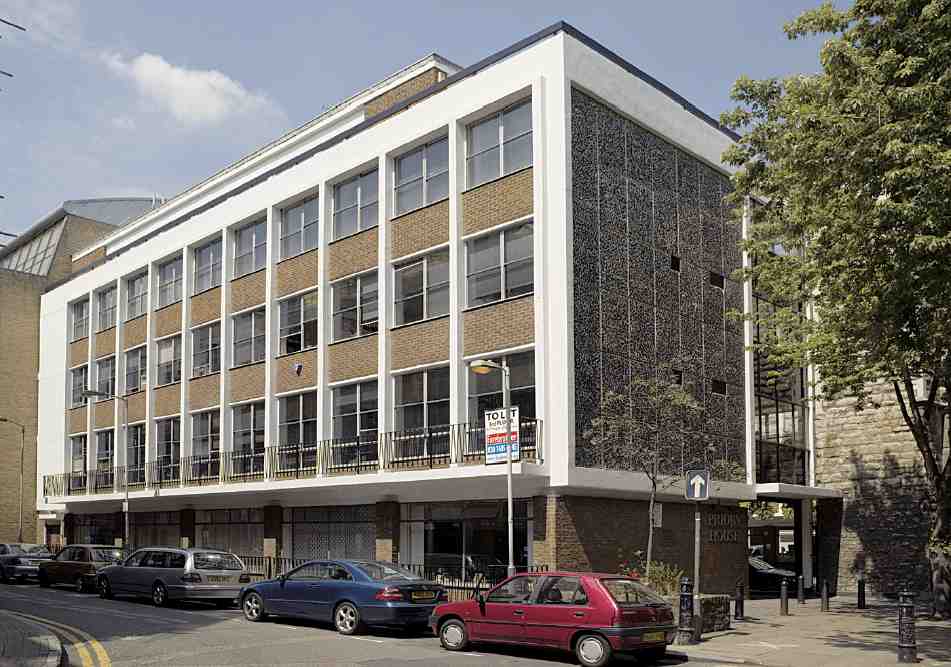
202. Priory House, St John's Lane frontage, 2006. Alec Shickle, architect, 1960–2
Priory House Nos 22–24 (with Nos 18–26 St John's Square)
Completed in 1962, this office building was the first major post-war redevelopment scheme in the area of St John's Gate, in a particularly sensitive location, immediately adjoining the historic edifice.
The greater part of the site had been cleared before the war by the Order of St John for a new headquarters, but the scheme was abandoned in 1951 with only the basement completed (see above), and in 1955 the Order offered the site for redevelopment, along with an adjoining building on Briset Street formerly occupied by its stores department.
Proposals were restricted to offices, a decision supported by the local planning authority despite the area having been zoned by the London County Council for industry. The Order also insisted that any design should respect the scale and character of the gatehouse and hopefully 'set a standard for the coherent re-development of St. John's Square'. The final scheme had to be approved by both the Order's architects, Seely & Paget, and the Royal Fine Art Commission (RFAC). (fn. 115)
In May 1959 an acceptable offer was received from Central Urban Properties Ltd, one of the Land Investors group of companies owned by West End developers Philip and Jack Rose. But the first designs by their architect— Alec Shickle of Campbell-Jones & Sons—were for an unashamedly large and modern building that threatened to dwarf the Gate. Objections were raised not so much to the contemporary architectural idiom, but rather the scale and varied materials of the building. Indeed, the Finsbury Borough planners preferred a modern to a traditional design, as they thought the latter 'would compete with the period character of the Gate House'; and by March 1960, once Shickle had responded to the Royal Commission's criticisms, reducing the size of the block and simplifying the elevation, the Order was willing to accept his revised plans on Seely & Paget's recommendation. (fn. 116)
The new building, Priory House, was completed in August 1962, incorporating the existing basement. The Order of St John took a large part of the basement and ground floor for its new stores, and by the end of the year the rest of the building had been let to the Smithfield meat-importers Thomas Borthwick & Sons Ltd. (fn. 117) Other early occupants included the architects Clifford Culpin & Partners, and the Metropolitan Construction Co. Ltd, civil engineers. (fn. 118) During the 1980s the Times Literary Supplement and Times Educational Supplement had their offices here. (fn. 119)
Shickle's design is characteristic of its period, with brick and concrete curtain walls on a reinforced-concrete frame (Ill. 202). The planning echoed the aborted headquarters scheme, with the offices arranged on three sides of a courtyard. This gave occupants a view of the west wall of St John's Gate, the southern part of which was restored by the developers. The only stylistic acknowledgement of the building's historic surroundings was the treatment of the end walls with knapped flint panels, a feature which seems to have survived from Shickle's initial scheme despite being deemed 'unsatisfactory' by the Royal Commission. (fn. 120) The dark flint was chosen specifically to complement the sooty stone (not flint) facing of the Gate which, ironically, has since been cleaned.